Global Warning: the threat to climate defenders in Australia



Acknowledgement of Country
The authors acknowledge the Traditional Owners of Country throughout Australia and recognise their continuing connection to land, waters, and culture. We pay respect to elders and acknowledge the Traditional Owners who have cared for Country since time immemorial. Sovereignty over this land was never ceded – it always was, and always will be, Aboriginal land.
Disclaimer
While this report does not suggest any illegal or improper conduct on the part of any of the individuals or organisations named, the picture that emerges is of a government in thrall to coal; a situation that is dangerous for Australian democracy and terminal for our climate.


1 Global Warning: the threat to climate defenders in Australia
This report was authored by Yusur Al-Azzawi (Senior Lawyer, Human Rights Law Centre), Katrina Bullock (General Counsel, Greenpeace Australia Pacific) and Rachael Barwick (Solicitor, Citizen Representation Program, Environmental Defenders Office). Cover: On 20 September 2019, just days before the United Nations Climate Change Summit in New York, protesters at the Sydney Climate march joined millions of people around the world striking from school or work to demand urgent measures to stop the climate crisis. © Marcus Coblyn Greenpeace Foreword 2 Executive Summary 4 Context 6 Political power and influence of the fossil fuel industry 10 Anti-Protest Laws 16 Queensland’s “Dangerous Devices” Law 19 Tasmania’s Anti-Protest Law 20 Law Enforcement 22 Bail Conditions 24 Excessive Penalties 26 Stifling Civil Society 30 Defunding Climate Change Education 32 Threatening Charities who Engage in Climate Activism with Deregistration 33 Attempts to Stop Charities from Engaging in Climate Activism 36 Targeting Activism with Litigation 38 Corporate Surveillance and Direct Infiltration 42 Recommendations 46 A. Strengthen Australia’s Democracy 46 B. Strengthen Legal Protections for Activism 47 Endnotes 48 Contents
When it comes to protecting our futures and the future of our planet, young people around the world are increasingly turning to activism as governments fail to deliver real action. This is certainly the case in Australia, where instead of establishing a holistic climate policy or matching the US and UK on climate targets, our federal government consistently refuses to be accountable and proposes band aid solutions.
When pressed on Australia’s response to the IPCC’s climate report declaring a “code red for humanity,” our Prime Minister Scott Morrison asked if we’d taken a look at China. It’s a question that could be thrown right back to him – at least China has long had a net-zero emissions target, and more than half of the coal they do burn is imported from Australia. Our PM also ignores the fact that in the period of time that Australia had very firmly established its economy on fossil fuel extraction and exports, China was still in the process of doing so, and Australia has had a much larger window to transition away from fossil fuels.
In response to UNESCO declaring that the Great Barrier Reef should be put on a list of World Heritage Sites that are “in danger” due to climate impacts, the federal Environment Minister spent time and taxpayer money traveling to countries on the board of UNESCO lobbying against the listing, rather than acknowledging the direct threat facing the reef from climate change.
Coalition MPs have called for an increase in funding to the government’s school chaplaincy program to address concerns that climate ‘activism’ is causing anxiety for Australian children, rather than implementing policy that assures us of a safe and liveable future.
With this constant deflection and deception, we’ve lost all faith in our government acting for young people. Ninety-three percent of young people surveyed by Foundations for Tomorrow said that the government needs to be doing more on climate change. We’ve realised that we have to take matters into our own hands, because we’ve run out of time to watch them dance around the issue while those on the frontlines of climate change watch their livelihoods slip away to the climate crisis.
Personally, I am fighting for climate justice for my home country of India, an equatorial state that will be one of the worst hit and worst equipped to deal with the climate crisis. Natural disasters like floods and fires devastate the country regularly, and some spring mornings, the temperature has reached 45°C by 9am. Having the privilege to move to Australia when I was only 10 months old, this is not something that I have had to experience. Rather, I’ve experienced the panicked phone calls back home, the flicking through news articles, the anger at the government’s inaction and the survivor’s guilt.
Traditional Owners of this land from the time of invasion have been at the forefront of climate activism and protection of Country. I wonder if this sense of climate devastation and despair is something that our politicians will ever have to experience.
Student strikes for climate have become increasingly popular in recent times, with a student strike in Naarm (Melbourne) in 2019 bringing 150,000 people to the streets calling for climate justice. However, alongside that, young people are finding more and more avenues to make change. One of these is through legal action.
Sharma v Minister for the Environment, the class action of which I am the first named applicant, has established that Australia’s federal Environment Minister owes all Australian children a “duty of care” to avoid causing us harm from the impending impacts of climate change. This is a landmark decision based on science. However, the Minister has appealed the decision and is seeking to have the finding overturned.
All of us who brought the case are under 18 so we needed a “litigation representative” to help bring the case to court. Sister Brigid Arthur, who has experience in helping young people in the court system, generously became involved and the court appointed her to represent us.
When we brought the case our lawyers took it on pro-bono. For the appeal, we tried to match the unlimited, tax-payer funded resources of the Minister and have raised thousands of dollars due to the generosity of over 5,000 individuals. We were humbled by the support.
Our case sought to develop the common law and establish a new duty to protect vulnerable children in line with the centuries of case law. But nobody is ever assured of winning. In Australia, the successful party to court action can secure a court order for the unsuccessful party to pay the other party’s legal costs.
This raises important questions – what about those who don’t have access to pro-bono legal representation and crowd funds? What about young people who can’t go to court without the help of someone like Sister Brigid? What about those who are scared of losing everything if they don’t win? How many legitimate claims to uphold people’s rights have not been brought because of these obstacles?
Under international law, courts should be equally and indiscriminately accessible to all.
Before turning to climate litigation, I was largely involved in student strikes. Hours have been dedicated to legal research in the process of strike organising. I was surprised at how easy it was for strikers to get in trouble just for trying to make their voices heard. You will be hard pressed to find an activist that hasn’t either had a confrontation with the police, or knows someone who has.
My fellow litigant Izzy Raj-Seppings went viral when she faced riot police at her first ever climate protest at the age of 13 outside Kirribilli House. A quick Google search will find you the picture of a 13-year-old crying and staring down police officers telling her “you may be arrested, force may be used.” How is the threat of arrest and force justified towards a 13-year-old peaceful protestor?
I have a friend who is set to face the Children’s Court for peaceful, compliant obstruction of a roadway during a civil disobedience action. This involved them mounting a tripod and occupying a quiet road. No one was put in danger and all activists present were fully compliant, however they were still arrested on four separate charges.
Events like these are why I turned to a legal challenge, feeling almost as if it was a more practical option to pursue a legal case to sue a government Minister than risk arrest as a young woman of colour.
This report connects the dots to reveal a web of systemic strategies that appear designed to dissuade and deter young people and others fighting for a better future from having their voices heard.
Young people are engaging in activism because we have to. This is an emergency. Instead of targeting the messengers, it’s time for governments to heed our message.

2 3 Global Warning: the threat to climate defenders in Australia
Anjali Sharma Applicant in Sharma v Minister and School Striker
Foreword
Executive Summary
The climate crisis is the greatest challenge of our time. Advocacy and protest are vital to ensuring that the best interests of people, the planet and future generations guide our governments’ responses, not the vested interests of the fossil fuel industry. While powerful corporations use money and access to influence government, advocacy and protest are how people and communities build the visibility and awareness needed for change. But in recent years in Australia the ability of communities and organisations to advocate for stronger climate action has come under sustained attack, which is distorting policy and damaging our democracy in the process.
Below:
Thousands of Sydneysiders converged at Sydney Town Hall to take part in a large scale demonstration protesting the government’s inaction on climate change and the ongoing bushfire crisis across NSW in December 2019.
© Dean Sewell / Greenpeace
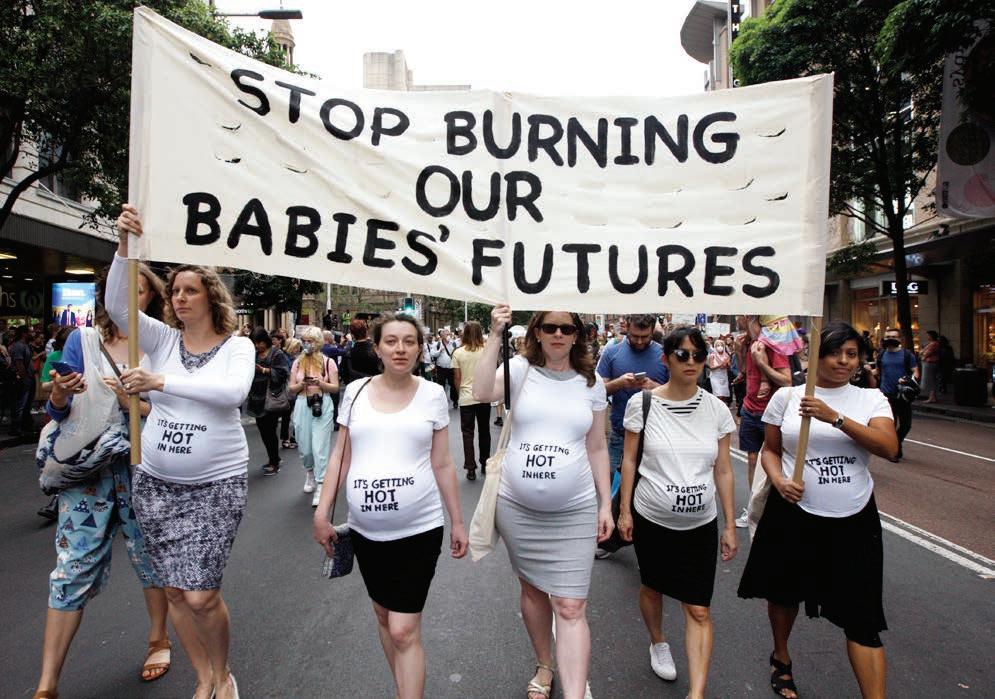

Inset:
Members of the
and the Pacific Ocean as a nuclear highway for plutonium ships.
© Greenpeace Tim Cole
This report documents the importance of climate activism in Australia, maps the systemic repression faced by climate activists across the country, and examines the unregulated political influence of the fossil fuel industry driving that repression.
In recent years state and federal governments in Australia have introduced a suite of regulatory measures designed to restrict climate activism. Climate defenders are routinely receiving disproportionate and excessive penalties and bail conditions which restrict their freedom of association and assembly. The peak government climate communication body has been stripped of funding and charities who facilitate climate activism have been threatened with deregistration. Corporations and governments who engage in the surveillance and infiltration of Australian climate activist groups are rarely held to account, and corporations have a history of weaponising Australia’s legal system against climate activists through the use of strategic lawsuits against public participation (SLAPP), which are designed to censor, intimidate and silence critics.
To reverse this undemocratic slide, this report makes several recommendations to address the distorting influence of the fossil fuel industry in Australia’s democracy and to enact stronger protections for advocacy and protest rights under Australian domestic law.
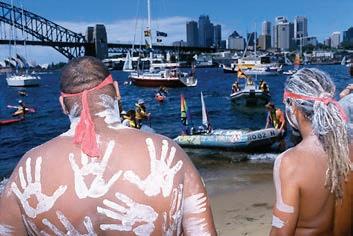
4 5 Global Warning: the threat to climate defenders in Australia
Right:
Sydney rally to protest the bulldozing of the Leard State Forest by Whitehaven Coal in June 2014.
© Greenpeace Abram Powell
Doonooch Aboriginal dance troupe look on as the 2001 Nuclear Free Tasman Flotilla prepares to sail to the North-West Tasman Sea where they protested the use of the Tasman Sea
Context
The right to freedom of association, including peaceful assembly, is a fundamental human right proclaimed in the Universal Declaration of Human Rights.1 This right is a bedrock which enables the participation of citizens in economic and social policy. Australia recognised the importance of this long-held principle when it became a signatory to the International Covenant on Civil and Political Rights (ICCPR).2 While the Australian Constitution does not explicitly protect freedom of expression, our High Court has implied some limited protection of political communication as an essential component of the democratic system the Constitution established.3
Australia is a signatory to the Paris Agreement under the United Nations Framework Convention on Climate Change (UNFCCC) and has committed to the Agreement’s targets and timeframes.4 Despite this commitment, Australia’s climate change policies are dangerously inadequate and lag behind those of other nations. The annual Climate Change Performance Index (CCPI) is an independent monitoring tool for tracking the climate protection performance of 57 countries and the European Union.5 The 2021 index ranks Australia as 54th in terms of climate performance and gives it an overall ranking of “very low performance”. This poor performance stems from a lack of political will due to the corrupting influence of the fossil fuel industry over Australian politics.
This lack of political will to act is at odds with popular consensus. Studies show that the majority of Australians believe global warming is a serious and pressing problem and that we should begin taking steps now to address it, even if this involves significant costs.6 Despite this, Australian politicians and media organisations routinely attack the people and organisations advocating for climate action, labelling them fringe, extreme, selfish and dangerous. Such rhetoric creates fertile ground for the repression of climate activism in Australia.
“Attempts to silence climate activism work in tandem with the amplificationof climate denialism and delayism in parts of our media and the politicalsystem. This creates a distortion in the perception of community viewsabout the scope of climate and environmental concern. This kind of rhetoriccreates the false impression that only a few of us harbour concerns aboutthe climate and that there are a large number of climate change deniers. But research reveals the truth – less than 10% of Australia’s population, a vocal micro-minority, deny climate change. It is indeed this groupwho are the dangerous and selfish fringe.”
Rebecca Huntley Author and Social Trend Researcher
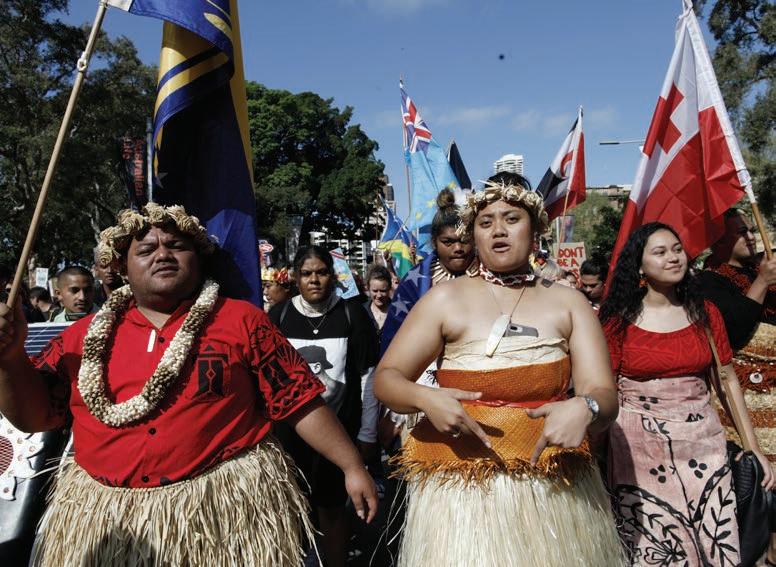
Attacks on animal rights activists
Australian Prime Minister Scott Morrison labelled vegan animal rights activists “un-Australian green criminals” following peaceful protests across Australia, and a demonstration at a New South Wales abattoir in which a small number of activists attached themselves to machinery.7 Prime Minister Morrison also made public comments inviting litigation against the activists, noting that the government was prepared to join a legal challenge if any landholder wanted to launch legal action against animal rights activists protesting on their farms.8
This report is an investigation into the systemic repression faced by climate activists across Australia with a particular focus on the increasing trend of regulatory measures designed to restrict climate activism.
Aboriginal and Torres Strait Islander peoples from the time of invasion have campaigned and organised for the protection of Country. Aboriginal and Torres Strait Islander peoples have lived sustainably off this land since time immemorial.
There has been a vast array of activism tactics, ranging from sit-ins on Country and surfer paddle outs to protest offshore oil drilling, to civil disobedience tactics used by groups such as Extinction Rebellion. Non-Violent Direct Action (NVDA) and public demonstrations continue to have a large presence. Sophisticated divestment campaigns and boycotts have also increased in recent years, particularly against large coal, oil and gas corporations.
Other forms of activism include the dissemination of information obtained via corporate whistle-blowers and artistic protest action through a variety of means including performance and photography. There continues to be a strong appetite for the use of climate change litigation as a climate advocacy tool, with Australia ranking second in the world for the number of climate litigation cases filed (as at May 2021).9 The Covid-19 pandemic has also seen a rise in digital activism including online petitions, letters to CEOs and government officials, social media campaigns targeting consumers, investors, donors, companies, and the general public, and boycotts against large corporations.
Attack on secondary boycotts
Prime Minister Morrison has also threatened to criminalise secondary boycotts against companies who provide services to the mining industry, labelling the boycotts “indulgent and selfish”, “a new breed of radical activism” undertaken by “anarchists” which “threaten the livelihoods of fellow Australians”. Australia’s then Attorney-General Christian Porter confirmed that the proposed changes were targeted at climate activism group Market Forces and that the government intended to apply penalties to secondary boycotts done for the dominant purpose of environmental protection.10
6 7 Global Warning: the threat to climate defenders in Australia
Right: Activists join their voices with millions of people around the world and march as part of the Global Climate Strike 2019.
© Dean Sewell Greenpeace
Climate activism has made major contributions to the health of Australians and the environment they love. Without climate activism Equinor, BP, Santos and Chevron would not have abandoned their risky oil drilling plans in the pristine waters of the Great Australian Bight.11 Australia’s four major banks would not have agreed to exit the thermal coal sector on or before 2035,12 and major Australian corporations like Coca-Cola Amatil, Bunnings Warehouse, Lion, Coles, Woolworths, Aldi and Officeworks would likely not have committed to sourcing 100% of their electricity from renewable sources by 2025.13 Despite the strides made by climate activists in Australia, climate activism is under threat.
The fossil fuel industry continues to wield significant power in Australian politics and enjoys grossly disproportionate influence in our democracy at this critical moment for the planet. Climate activism is of heightened importance right now, yet this disproportionate influence and access means the voices and wishes of powerful people and corporations are elevated above those of the general population who are calling for climate action.
The voices of Aboriginal and Torres Strait Islander peoples and young people in Australia are essential in climate activism. For those who have been disenfranchised by institutional powers, protest is a vital tool in generating power in politics. Protest empowers people and communities who are disproportionately affected by climate change.
Young people are some of the most exposed to the escalating impacts of climate change. Those under the age of 18 cannot legally vote, yet they have made sure their voices are heard, by creating one of the largest climate activism campaigns in Australia, the School Strike 4 Climate.14 Their activism has extended to one of the most important climate change cases in Australia, Sharma by her litigation representative Sister Marie Brigid Arthur v Minister for the Environment, 15 where eight teenagers instigated an action that led the Federal Court to hold that the Minister of Environment has a duty of care to protect young people from the climate crisis.
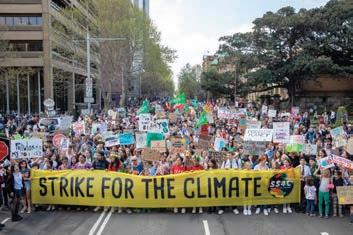
In September 2019 hundreds of thousands of young Australians participated in a public climate strike demonstration known as the School Strike 4 Climate.16 Australian Prime Minister Scott Morrison responded by condemning the protests in parliament and stating that there should be “less activism in schools.”17 Youth activism in Australia has also extended to the corporate arena. After witnessing coal giant AGL’s inadequate response to the climate crisis, 18-year-old Ashjayeen Sharif responded by running for the AGL board of directors. Ashjayeen reasoned that “the current AGL board won’t have to deal with the climate-wrecking legacy of AGL’s dirty coal. It’s young Australians that will suffer the consequences – from devastating bushfires to floods, heatwaves, droughts and the economic and social uncertainty that comes with a rapidly changing climate. That’s why I have become an AGL shareholder and nominated myself to join the AGL board”. Ashjayeen’s nomination gained enormous media attention and highlighted AGL’s ineffectual climate response in the lead up to its 2021 AGM. While the nomination was ultimately unsuccessful, it garnered the support of over 20,000 petition signatories and received over 7 million shareholder votes. It also pressured AGL’s board to agree to recruit an additional board member with further skills and expertise in climate change risk, Environmental, Social and Governance (ESG) and industry transition. The nomination campaign also drove support for a non-binding resolution put forward by the Australasian Centre for Corporate Responsibility asking investors to support AGL setting short, medium and long-term decarbonisation targets in line with the Paris Agreement. Despite AGL’s board advising against it, this resolution ultimately received 55% of the vote.
Inset:
At the Global Climate
in
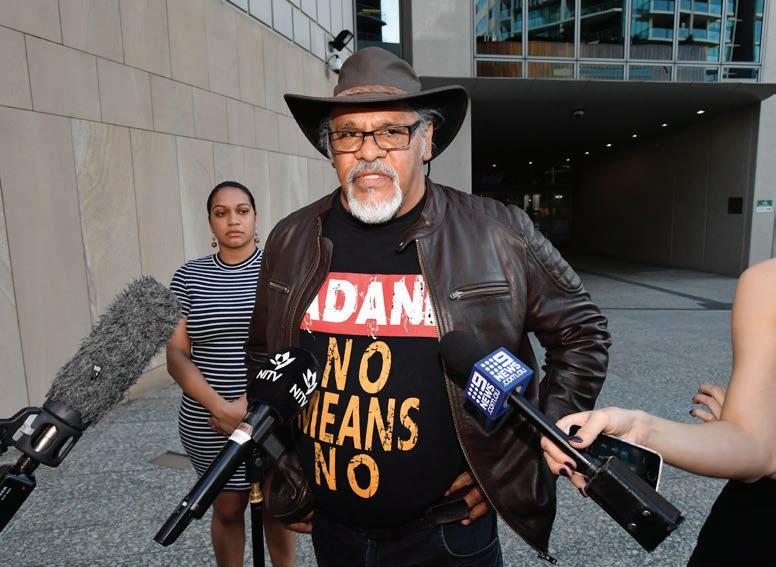
Aboriginal and Torres Strait Islander peoples in Australia also play a pivotal role in environmental activism. Many First Nations communities are at the front line of proposed development, including mining sites, logging areas and gas fields, and the attendant damage to ecosystems, sites and landscapes of cultural significance. The strength of First Nations peoples’ connection to and understanding of the land gives a unique and critical voice to the climate movement. However, amongst other things the remote setting of some First Nations communities can make efforts to bring issues to the forefront of public discourse and effectively reach a broader audience more difficult. Many First Nations communities are engaging in blockades, creative protest actions and travelling large distances to raise their concerns in capital cities.
Wilcannia protests
In Wilcannia, a small town in far west New South Wales with a population of 745,18 protests over the management of the Barwon-Darling river system have provided hope to the townspeople,19 who are mainly Barkindji Traditional Owners.20 Numerous protests have been held, with notable actions in 2016, 2018, and most recently in 2020, all stopping traffic flow over the Wilcannia Bridge.21 However locals say the government has not responded with meaningful change.22 Concern in the community over the health and survival of the river system is growing. The most recent protests seeing six people arrested and two Barkindji women charged as a result of the action.23
Traditional Owners’ anti-fracking activism
In the Northern Territory, many Aboriginal and Torres Strait Islander peoples from remote communities are taking their protest action to the city to reach a greater audience. Following the Northern Territory government’s 2018 decision to lift its moratorium on fracking, Traditional Owner, Conrad Rory, used a bobcat to drill holes in the grass outside the Northern Territory Parliament House in Darwin. Mr Rory undertook his action in the city, more than 970km from his Traditional Lands in Borroloola, Northern Territory. Mr Rory said “[n]oone cares what happens out there, (but) once you put a bobcat on parliament lawn, everyone goes berserk”.24
Tour de Carmichael
In Queensland, the Wangan and Jagalingou people brought attention to their traditional lands by blocking a dirt access road to the Adani Carmichael coal mine. The sit-in resulted in trucks trying to access the site being turned away.25 There was a strong police presence, however no arrests or charges flowed from the action. Following this, the Traditional Owners have engaged in creative protest action to bring people to their land and draw attention to their concerns through the Tour de Carmichael – Cycle for Country. This is an 85km guided bike tour through Wangan and Jagalingou Country explaining the significance of cultural sites and the threats of the coal mine on the natural and cultural environment.26
8 9 Global Warning: the threat to climate defenders in Australia
The rise of youth activism
©AAP
Context
Right: Wangan and Jagalingou man Adrian Burragubba is a Traditional Owner who has played a pivotal role in protests opposing mining giant Bravus (formerly Adani) and its activities in the Galilee Basin.
Photos
Strike
Sydney on 20 September 2019 protesters joined millions of people around the world striking from school or work to demand action on climate change.
© Marcus Coblyn Greenpeace
Political power and influence of the fossil fuel industry
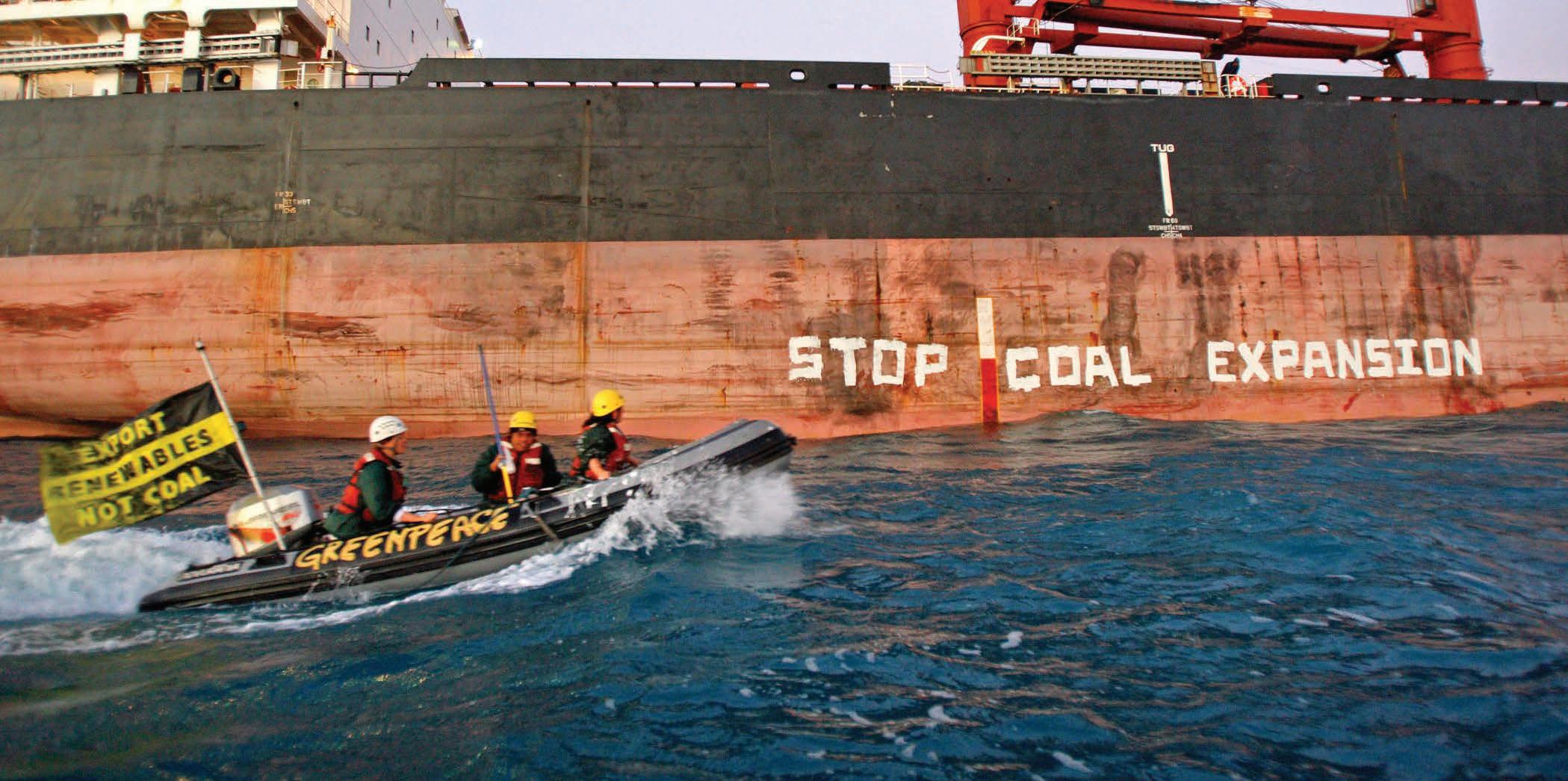
Key summary
1
2
3
The web of connections between Australian governments and the fossil fuel industry are driving political inaction on climate change and the repression of the people and organisations who challenge that inaction.
Climate policy is being distorted by the fossil fuel industry’s ability to make large donations within a deeply flawed regulatory regime.
A suite of political integrity measures, including reform of political donation laws and the establishment of a strong federal integrity commission, are needed to curb this distorting influence and restore balance in Australia’s democracy.
Greenpeace activists in an inflatable raft travelled along a queue of almost 50 coal ships at Hay Point Port, Queensland. The peaceful action in 2008 was to highlight the Rudd Government’s plans to rapidly expand coal exports while the world was trying to cut global emissions. © Greenpeace Sebastian Capa
Political power and influence of the fossil fuel industry
There is a vast web of relationships between Australia’s federal government, its biggest coal companies, fossil fuel industry groups, lobbyists and media organisations, which is halting action on climate change and stalling the transition to clean energy.27
Donations from the fossil fuel industry to political parties are steadily increasing, allowing the industry a disproportionate and distorting influence in politics. A report from the Australian Conservation Foundation28 found that over 2018-19, the fossil fuel industry declared donations of almost $1.9 million to Australian political parties (excluding Clive Palmer’s United Australia Party), but the actual figure is likely much higher.29
Big political donations are intended to have political influence. There is a sliding scale of influence enabled by political donations,30 to the extent that it has been recognised by the High Court.31 Several forms of influence have become prevalent in our political system.32
Dark Money
The total volume of unexplained income for major parties between 1998-99 and 2018-19.
Source: Centre for Public Integrity
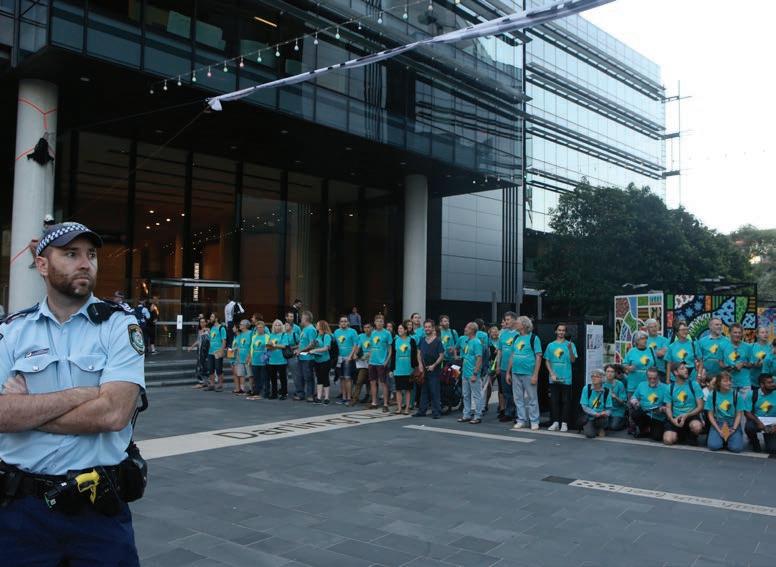
Donations from the fossil fuel industry are being made within a deeply flawed regulatory regime. There are currently no caps on federal political donations meaning that industries and corporations can donate as much as they like. Further, in the 2018-19 financial year, a total of over $102 million of the major parties’ income was from undisclosed sources33 and in 2016, 40% of political parties’ income had “no identifiable source”.34 Research from the Centre for Public Integrity found that over the past two decades, around $1 billion of contributions with an unknown source – dark money – were made to political parties.35
The absence of donation limits and free flow of dark money underscore the core problem with Australia’s current political donations scheme: powerful industries are able to secretly buy seemingly unlimited access and influence. Climate activists will continue to face significant repression, and their calls will continue to fall on deaf ears, for as long as the fossil fuel industry wields such disproportionate influence in Australia’s political system. A suite of political integrity measures – a ban on large political donations, stronger lobbying rules and the establishment of a strong federal integrity commission – are needed to restore balance in Australia’s democracy and to ensure that the best interests of the people and the planet guide government decision-making, not the interests of big business.
12 13 Global Warning: the threat to climate defenders in Australia
100m 80m 60m 40m 20m 0 2000–01 2005–06 2010–11 2015–16
Right: Hundreds of community activists converged on Commbank’s headquarters in 2017 urging the bank to stop playing with their future by investing billions of dollars in coal.
© James Alcock / Greenpeace
Political power and influence of the fossil fuel industry
WA’s influential fossil fuel lobby
The majority of Australia’s gas industry is located in Western Australia (WA), including about 90% of Australia’s estimated recoverable reserves of conventional gas.36 The majority of gas produced in the state is transformed into liquid natural gas (LNG) and exported overseas. Chevron, Woodside and the Australian Petroleum Production and Exploration Association (APPEA) are some of the major players.
APPEA has advocated for specific policies that undermine action to address climate change and could facilitate environmental degradation. This includes calling for the reduction of environmental protection regulations,37 and the removal of the ‘water trigger’ from the Environmental Protection and Biodiversity Conservation Act 1999 (Cth), a requirement of federal Environment Minister approval when a coal seam gas or coal mining development will have, or is likely to have, a significant impact on a water resource.38
The gas industry is WA’s largest emitter of greenhouse gases (GHG). Most of the LNG-related carbon emissions in WA are caused by Woodside and Chevron. The two companies alone emitted a total of 22.3 million tonnes of carbon in 2018/19.39
The Western Australian gas industry uses a broad range of tactics to exert influence in WA’s politics, including gaining direct access to ministers and the Premier, making substantial political donations and helping facilitate a revolving door between staff in the gas industry and government positions.
For example, the Captured State report40 found that Woodside, Chevron and APPEA were involved in at least 100 meetings with WA Government ministers, including Premier Mark McGowan, between June 2017 and June 2020.41 The report also found that meeting dates often corresponded with political donation dates, with 10 instances of gas corporations donating to WA Labor or the federal ALP within five days of a meeting between a Labor minister and the corporation.42
Further, the report found that four of WA’s last five premiers (Mark McGowan, Colin Barnett, Alan Carpenter and Richard Court) employed staff who had worked for or went on to work for APPEA.43
According to Market Forces, major players in the gas industry made donations totalling close to $1 million to the ALP and Coalition in 2018-19, making up 6 of the 10 biggest donors.44
Chevron’s donations, which totalled $124,685 in 2018-19, corresponded with the abolition of the carbon price. The company’s donations in the four years leading up to the repeal of the carbon price (in July 2014) were 16% higher compared to the four years after.45
While it is impossible to identify all political outcomes that may have been influenced by the gas industry’s close relationship with the WA Government, there are several significant examples.
The WA Premier, Mark McGowan, voiced his concerns on the recommendations for regulation of GHG emissions made by the EPA following public outcry from the gas industry and an “urgent roundtable” in which Premier Mark McGowan and two other ministers met with representatives of the gas industry.46 Following the meeting, the EPA withdrew its recommended guidelines, which had required major WA resources projects to offset 100% of their GHG emissions, citing the need for further consultation with industry and stakeholders.47
Another example is the gas industry’s failure to meet carbon offset requirements. Chevron’s Gorgon project is one of the highest emitters of GHG in WA48 and has drastically failed to meet its offset target49
There is also compelling evidence that the WA mining industry was behind the push for devolving federal environmental approval powers to the WA Government. Rio Tinto wrote to the Morrison Government in support of these changes stating that federal processes were causing delays and increasing costs for the mining industry. Rio Tinto subsequently had four meetings with federal environment officials where reform of Australia’s environmental laws were discussed.50 Ten months after the initial letter was sent and prior to the completion of the federal government’s independent review of the national environment laws by Graeme Samuel, the federal government announced it would put a streamlining bill to Parliament. The bill proposed to facilitate “legally robust devolution of environmental approvals to States and Territories”.51 Rio Tinto’s iron ore projects were also put on a list of “fast-tracked” projects.52
Timeline
Meetings, political donation dates, policies.
2019 6 March 14 March 16 March 19 March 21 March 22 March
EPA released a new draft policy on greenhouse gas emissions
Chevron has a meeting with Labor Minister
Chevron donates $2,400 to Labor Party
Chevron and Woodside have meeting with Labor Ministers
Premier McGowan voices concerns regarding EPA green house gas emission guidelines
Chevron
$3,000 to Labor Party
Based on information sourced from: pdf page 8, 350 Boorloo Perth, ‘Captured State: The influence of the gas lobby on WA’ (Report, 350.org, December 2020) <http://350perth.org.au/captured-state/>.
14 15 Global Warning: the threat to climate defenders in Australia
donates
Chevron has a meeting with Labor Minister
Chevron donates $1,700 to Labour Party
LNG Taskforce meeting held between Premier
McGowan and Chevron prior to Shanghai
LNG Conference
Anti-Protest Laws
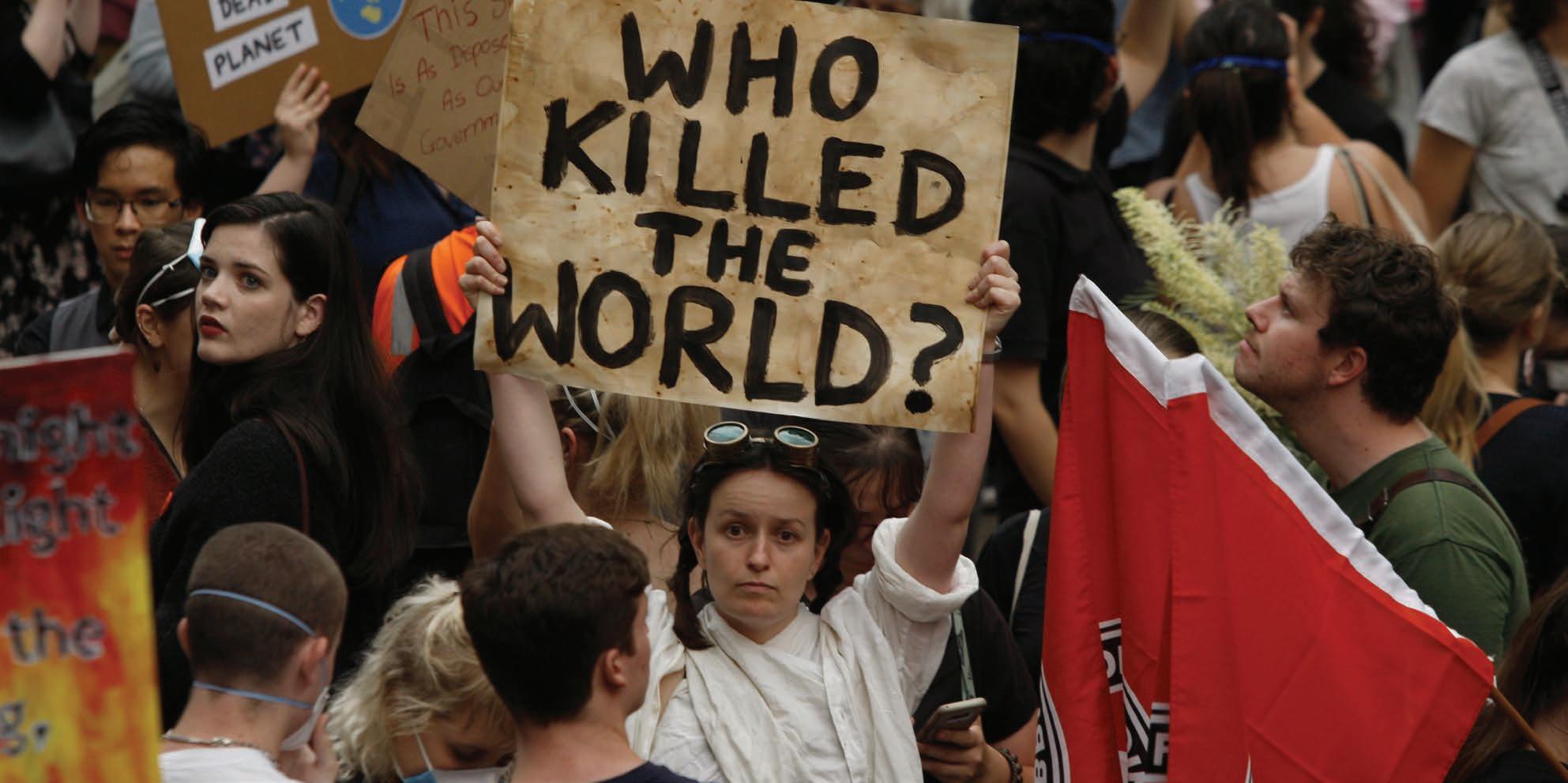
Key summary
1 There has been a worrying proliferation of new anti-protest laws across Australia.
2 These laws often directly target or disproportionately impact climate activists.
Activists at the bushfires and climate emergency rally in NSW 2019. © Dean Sewell Greenpeace
Anti-Protest Laws
Governments have a positive duty to facilitate peaceful protest under international human rights law, including by ensuring people are not prevented from exercising their protest rights by other groups or private companies. Governments must also ensure that any restrictions on protest action are limited to what is strictly necessary and proportionate in pursuit of a legitimate purpose.
Despite these human rights obligations, there has been a worrying proliferation of anti-protest legislation in Australia in recent years. These new laws often directly target or disproportionately impact climate defenders.
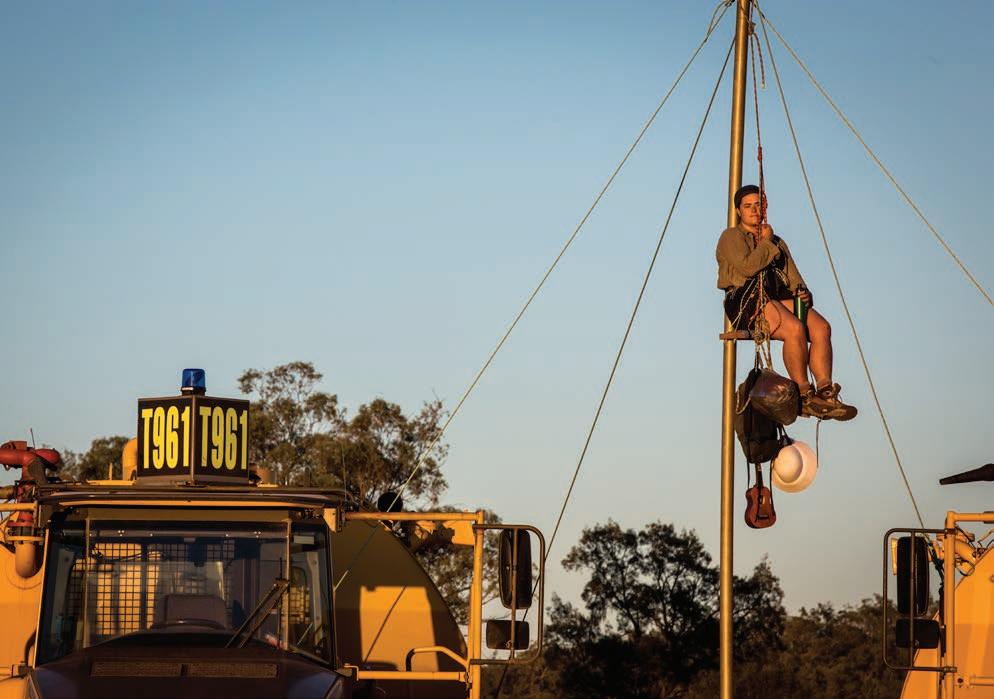
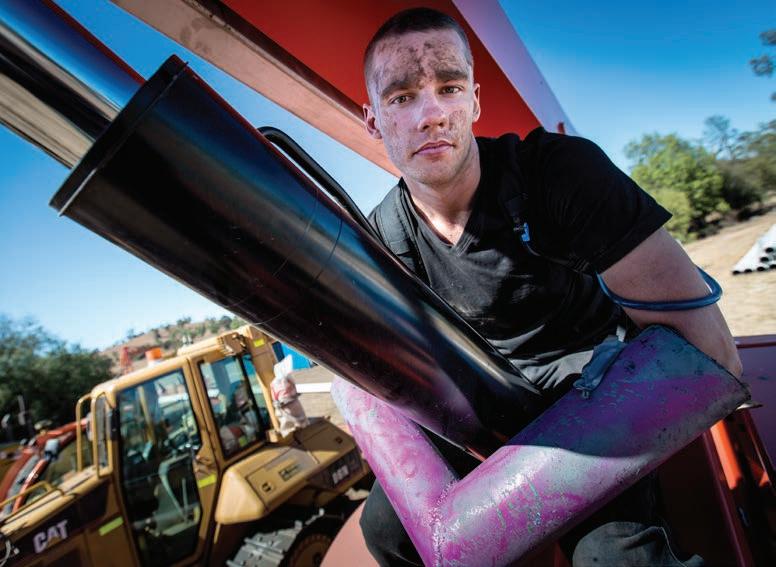
Queensland’s “Dangerous Devices” Law
On 24 October 2019, the Queensland Parliament passed the Summary Offences and Other Legislation Amendment Act 2019 (the Dangerous Devices Act). The Dangerous Devices Act was introduced to Parliament following a series of high-profile protest actions by climate defenders,53 with the law’s Explanatory Memorandum also referencing animal welfare advocates and people protesting against coal mining.54
The Dangerous Devices Act criminalises the use of several devices which are a common feature of peaceful protests, such as monopoles, sleeping dragons and tripods, even when the devices are used in a manner that only causes minimal disruption to the public and business. Under the new law, protesters who use dragon’s dens55 in a way that prevents a person from entering a shop, or who disrupt mining equipment for ten minutes, could face prison terms of up to one year.56
The Act also enables police to bypass the usual court process by issuing on-the-spot fines.57
The Dangerous Devices Act’s provisions are broad and uncertain, with key terms such as “unreasonably interfere” and “reasonable excuse” not clearly defined.58
In seeking to justify the new law the Queensland Government labelled Extinction Rebellion protesters as “extremists” who used “sinister tactics”.59 Premier Annastacia Palaszczuk told Parliament that lock-on devices in Queensland were being “laced with traps” such as glass fragments and butane gas containers,60 but refused to provide any evidence in support of these claims.61 In any event, Queensland law already addresses harmful conduct or use
associated with lock on devices62 and the terms of the Act go far beyond such conduct.
The Dangerous Devices Act is an excessive limitation on people’s protest rights and democratic freedoms. Multiple UN Special Rapporteurs have expressed concerns that “the Act allows for the criminalisation of peaceful protests” and is “inherently disproportionate”.63
“The Dangerous Attachment Devices legislation appears to have been specifically created to demonise protesters with no evidential basis. We raised strong concerns about the expansion of police powers included in the bill, notably in establishing an additional basis for searches. Since its introduction we’ve seen people walking nearby protests stopped and searched for “devices”, where there is no apparent grounds for such a search.”
Action Ready
18 19 Global Warning: the threat to climate defenders in Australia
Right:
An activist locks themselves to a tractor using a “sleeping dragon” protest device in a blockade at Maules Creek Coalmine in Australia.
Left:
© Tom Jefferson / Greenpeace
An activist on a monopole blockading the path to Maules Creek Coalmine in Australia in 2014.
© Tom Jefferson / Greenpeace
Anti-Protest Laws
Tasmania’s Anti-Protest Law
In September 2021, the Tasmanian Government released a proposed new anti-protest law, the Workplaces (Protection from Protesters) Amendment Bill 2021 (the 2021 Bill). The 2021 Bill is the Tasmanian Government’s third recent attempt to legislate unnecessary and disproportionate restrictions on people’s right to peaceful advocacy.
In 2017, the High Court struck down parts of the Workplaces (Protection from Protesters) Act 2014 (the Act) on the basis that several provisions were an impermissible burden on the constitutionally protected freedom of political communication (Brown v Tasmania).64
In March 2021, the Workplaces (Protection from Protesters) Amendment Bill 2019 (the 2019 Bill) – a law which purported to respond to the High Court’s ruling but which could have criminalised people for handing out fliers on a footpath –was voted down by the Tasmanian Legislative Council after being criticised as ineffective, broad and unnecessary.
The new Bill maintains much of the content from the 2019 Bill but seeks to address some of its criticisms by, amongst other things, increasing some offence thresholds, reducing maximum penalty levels and removing excessive police powers.
However, like its predecessors, the 2021 Bill creates offences for conduct that is already captured by existing law and strips away important safeguards like warnings prior to arrest.65
The new offences created by the 2021 Bill include trespass on business premises or business vehicles with intent to obstruct business activity, and the obstruction of a public thoroughfare or critical infrastructure with intent to obstruct business activity. These provisions are all unnecessary. Existing laws relating to unlawful entry on land,66 common nuisance,67 and public annoyance68 already address the conduct the new Bill purports to target.
The new Bill is also disproportionate, attaching dramatically increased prison sentences of up to 12 months to conduct covered by existing laws in circumstances where that conduct may have an activism-related motive.69 Concerningly, the 2021 Bill provides for even higher penalties when conduct occurs in aggravated circumstances.70
For a person to be found guilty of such an offence, their conduct need only “indirectly” cause serious risk to the safety of themselves or another person, regardless of whether this risk is a direct result of their actions or whether the risk eventuates.71 If the 2021 Bill passes, a person convicted in circumstances of aggravation under the Act could face imprisonment even though they did not intend, and their conduct did not cause, any harm to another person.

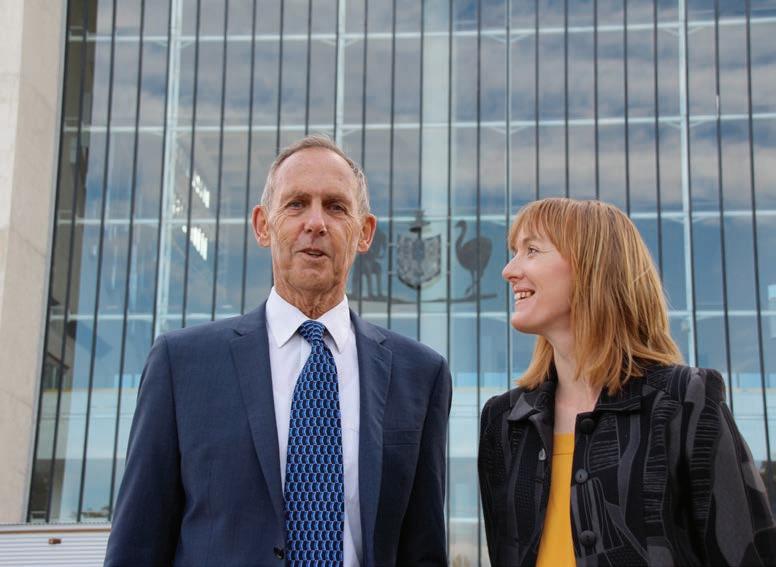
The definition of several key terms in the Bill, like “business premises” and “critical infrastructure” are broad and unclear, and important thresholds, like obstructing business activity “to a substantial extent”, are vague and subjective.
The Bill’s disproportionate penalties, vague definitions and subjective thresholds create a legislative scheme that would have a significant chilling effect on democratic activism and protest in Tasmania.
Much like the two previous Bills, the Tasmanian Government’s latest anti-protest law is disproportionate, unnecessary and undemocratic. It should be withdrawn.
Left:
On 25 January 2016, Dr Bob Brown was arrested whilst walking near forestry operations in the Lapoinya Forest in Tasmania. He was later charged under the Workplace (Freedom from Protesters) Act 2014 (Tas) for failing to comply with a police direction to leave a business access area. He successfully brought a challenge in the High Court as to the constitutional validity of the Act.
© Bob Brown Foundation
Tasmania’s unconstitutional anti-protest law
Dr Bob Brown and Ms Jessica Hoyt were arrested and charged under the Workplaces (Protection from Protesters) Act 2014 after entering Lapoinya Forest in Tasmania to raise public and political awareness about the logging of the forest. The Act makes it an offence to not leave a forestry area when directed to do so by police and both were charged under this provision. Brown and Hoyt commenced proceedings in the High Court of Australia to challenge the constitutional validity of the Act, arguing it impermissibly restricted the implied freedom of political communication. Although the State of Tasmania dropped the charges after proceedings had commenced, the High Court ruled that the plaintiffs had a real interest in the validity of the laws to understand whether or not the public were required to observe them. The High Court, in a 6-1 majority, held that the measures adopted by the Act to deter protesters imposed a significant burden on the freedom of political communication and therefore were unconstitutional.
21 Global Warning: the threat to climate defenders in Australia 20
Right: Dr Bob Brown and Ms Jessica Hoyt after the High Court of Australia hearing in 2017.
@ Human Rights Law Centre
Law Enforcement
Bushfire survivors
Melinda Plesman and Dean Kennedy are issued a move on order by Australian Federal Police (AFP) outside Parliament House in Canberra.
They delivered the remains of their home to Parliament House in Canberra, bearing the message “Morrison, your climate crisis destroyed my home”. Their family home of 35 years, in Nymboida, NSW, was destroyed by bushfires which tore through the town on 8 November 2019.
© Dean Sewell Greenpeace
“There has been a rise in coercive crowd control tactics, misuse of bail conditions and anti-protest provisions and laws over several years in the context of climate activism. This rise in systemic repression is taking place in the context of a near total lack of any clear, effective accountability processes.”
Melbourne Activist Legal Support
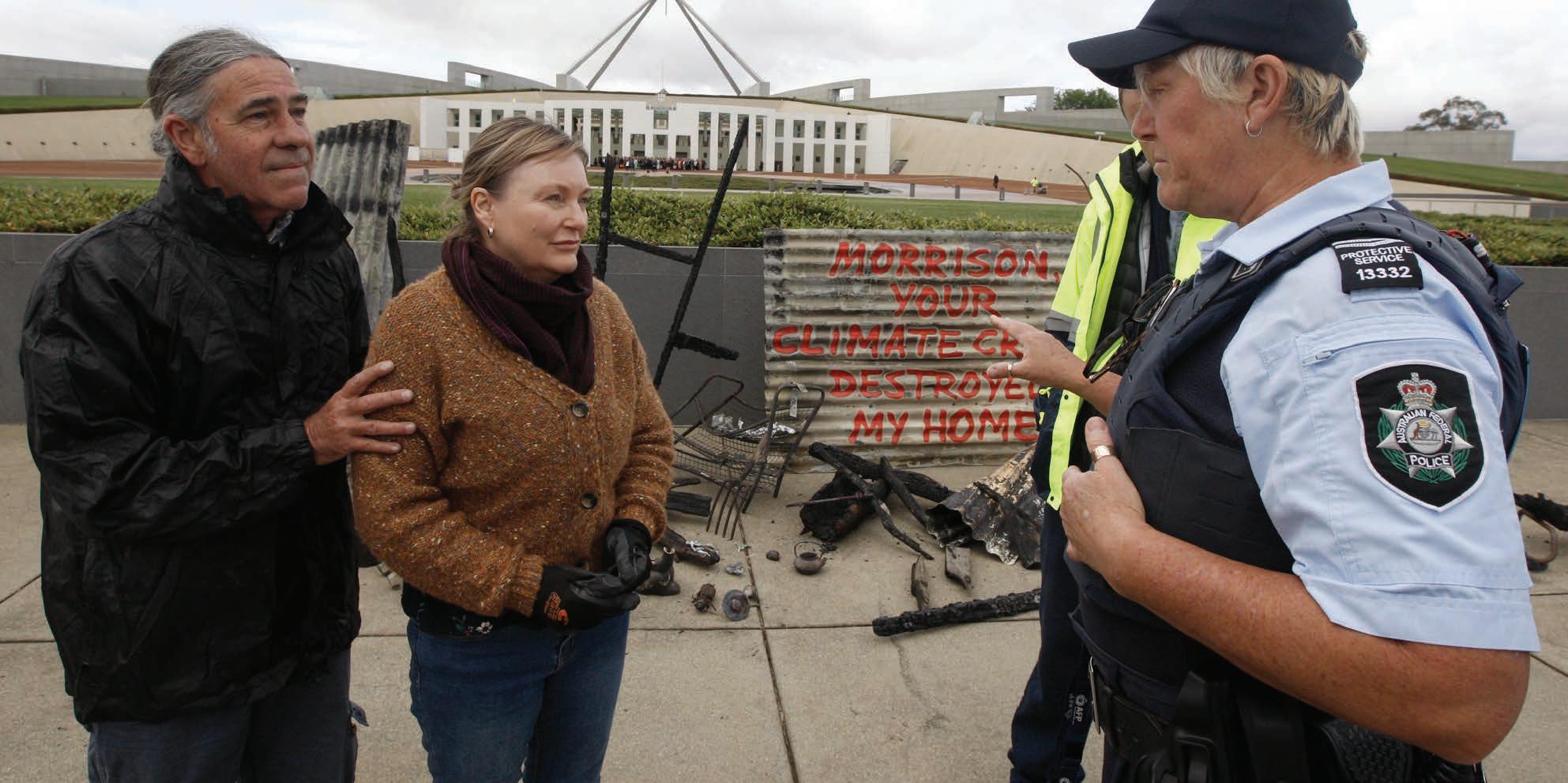
Key summary
1
Police are imposing onerous bail conditions on environmental activists, which stifle their freedom of association and political expression.
2 Climate activists are also facing excessive penalties for peaceful protest action, including suspended terms of imprisonment.
Law Enforcement
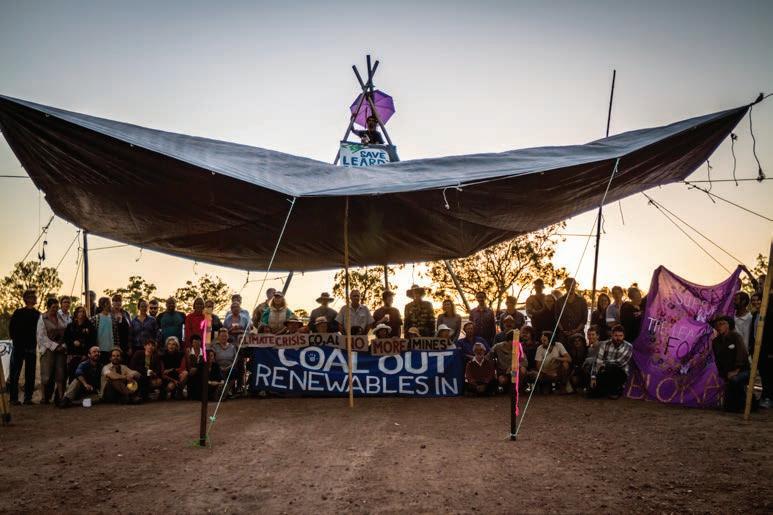
Bail Conditions
Activists across Australia are facing increasingly repressive bail conditions.72 Most criminal charges flowing from environmental activism are summary offences,73 but climate defenders are increasingly receiving bail conditions commonly imposed in circumstances of serious offending like organised crime. These conditions include non-association conditions, place restrictions and curfew conditions.74 Bail is designed to address risk,75 and yet it is being applied punitively and as a deterrent to activism.
“For years the police have been using certain bail conditions as a purely punitive measure against activists in Northern Queensland. This practice needs to be called out for what it is, an abuse of the law.”
Scott Daines (“Sooty”)
Frontline Action on Coal

Restricted movement
A place restriction bail condition was used to break up an activist camp in Queensland, set up on private property with the consent of the land owners. The place restriction prohibits activists charged from returning to the camp until their matters are finalised at Court. For interstate activists, this means being forced to return to their home state, making their attendance at court more expensive and onerous. This is an ongoing practice that has been utilised by police over many years. It contradicts one of the purposes of bail – to ensure attendance at Court – and has made it difficult for activists to defend their charges.76
In 2017 an activist was arrested for a peaceful protest outside the Commonwealth Bank in Sydney. She was part of a group protesting the bank’s investments in fossil fuels and had climbed a pillar to drop a banner. She remained there for around 20 minutes before being taken into custody. Despite having no history of violence, the police officer who determined bail conditions identified a concern that the activist, if released from custody, would “endanger the safety of victims, individuals or the community”. As a result, restrictive bail conditions were imposed. The activist was banned from going within 100 metres of a Commonwealth Bank area, which was interpreted to include ATMs. Given the ubiquity of Commonwealth Banks and ATMs, this severely restricted her access to public facilities like transport, shopping centres and communal areas.
Environmental activists have often responded to oppressive bail conditions by electing to spend a night in custody in order to go before the Court to determine bail, rather than agree to police bail conditions. This has often resulted in more appropriate bail conditions being imposed, such as good behaviour only.77 Activists who agree to police bail often apply to the Court to vary conditions. Applications that have had the greatest success are those in which legal representatives reinforced the purposes of bail, and expressly put before the Court that bail should not be used punitively.78
“Over the ten years I’ve been involved in social change activism I’ve seen a concerning trend, where bail conditions are used to punish protesters and stop them participating in important peaceful protest – going way above and beyond their intended purpose of ensuring people attend their court dates.”
Z Buckley Lennox, Activist NSW
24 25 Global Warning: the threat to climate defenders in Australia
Unfair bail conditions
Right: The climber hangs in protest from a pillar outside CommBank’s headquarters in Darling Harbour, Sydney after unveiling a large banner protesting the Bank’s investments in fossil fuels.
©James Alcock / Greenpeace
Left: Protesters block entry to Whitehaven’s controversial Maules Creek coal mine development in January 2014.
© Abram Powell Greenpeace
Law Enforcement
Excessive Penalties and Policing
Throughout Australia, there are examples of excessive penalties being imposed on environmental activists by some courts. The sentencing principles of deterrence and denunciation are given more weight, particularly when climate defenders do not express remorse or contrition for their activism. This can make the sentencing process more complex, with legal representatives needing to ensure that the activist’s motivation is considered. In Queensland, the Magistrates’ Court has imposed high sentences on activists protesting the Adani-Carmichael coal mine. On appeal to the District Court these sentences have been overturned and non-convictions and fines imposed instead.
Organisation Adani (now known as Bravus)
Conduct
Frontline Action on Coal (FLAC)
Consequences
Environmental breach
The coal port operator dumped water containing more than eight times the permitted amount of sediment onto a beach at Abbott Point during Cyclone Debbie in March 2017.
$12,190 fine
Issued a $12,190 penalty for a technical breach.79 Adani contested the fine, which led to a suit that was to be heard in the Bowen Magistrates Court.80
The parties then reached an agreement that Abbott Point Operations would install an automated system at its floodwater release point near the ocean worth $100,000. In return, the government dropped the suit and $12,000 fine.81
Demonstration
In 2018, several FLAC protesters chained themselves to coal loading equipment at the Abbot Point Port in protest against the company’s contribution to climate change.
$70,000+ in fines
Collectively fined more than $70,000, at first instance.
The fines for intentionally or recklessly interfering with a port’s operation were set aside on appeal and all nine protestors were re-sentenced to fines between $2,000 and $3,000 each.82
A Greenpeace activist is led away by police during a 2010 action at the Australia and New Zealand Banking Group (ANZ) state headquarters in Queensland. Greenpeace was highlighting the fact that ANZ had invested $1.6 billion in Australia’s coal industry in the preceding five years while claiming to be Australia’s “greenest” bank.
© Greenpeace
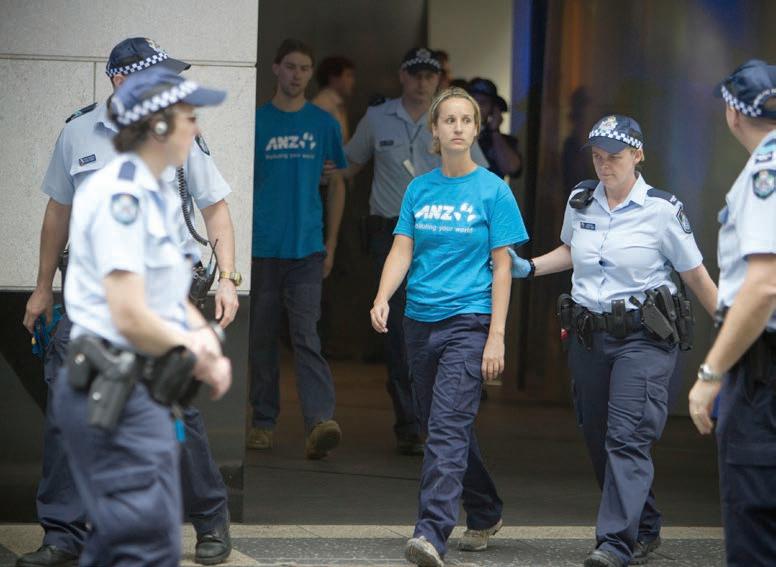
The Dangerous Devices Act in action
Two young adults who protested against the Adani-Carmichael coal mine pleaded guilty to protest-related offences including charges under the Dangerous Devices Act. At first instance, the Magistrate imposed a three-month prison sentence, suspended for two years, with convictions recorded. This was appealed to the Queensland District Court on the basis that the sentence was manifestly excessive. It was the first judicial test of the new laws. In the District Court the original sentences were set aside and a $1,000 fine was imposed on each person without convictions being recorded.83
This case created a useful precedent for environmental protesters. The judgment establishes that an act of civil disobedience, defined as a “public, non-violent, conscientious act contrary to law, done with the aim of bringing about a change in the law or policies of the government”, can create a moral difference between this and other types of offending.84
Port protest
Nine protesters from climate activism group, Frontline Action on Coal, chained themselves to coal-loading equipment at the Abbot Point Port in protest against the company’s contribution to climate change. They were collectively fined more than $70,000. In addition to charges of trespass and contravening police directions, the obscure charges of intentionally or recklessly interfering with a port’s operation were levied.85
“Penalties handed down by Magistrates on activists involved with the Adani campaign in North Queensland have consistently been among the highest imposed across the country. It’s taken many appeals to a higher court to get some sort of sanity into these sentences but they are still relatively high. It’s outrageous to be fined more for trying to protect the environment than going out and assaulting someone.”
Scott Daines (“Sooty”)
Frontline Action on Coal
26 27 Global Warning: the threat to climate defenders in Australia
Right:
Law Enforcement
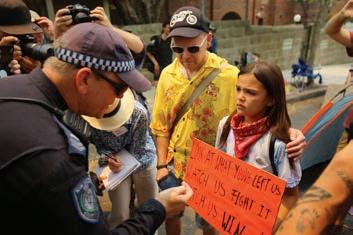
On 19 December 2019 adults and young people went to Kirribilli House in Sydney as part of the School Strike 4 Climate protests. Police presence at this protest was strong, with riot police entering the cul-de-sac outside of Kirribilli House just after midday to disperse the protesters. In formations of six or eight officers, riot police targeted individual protesters, giving each an official “move on” direction. One recipient of a direction was a 13-year-old girl who was present with her father. In her own words, she stated that “the officers approached the wall of students and protesters with intense intimidation tactics”.86 Surrounded by at least seven riot police officers she was ordered to move on from the scene of the protest or otherwise face arrest. She complied.87 Such intimidatory tactics could be seen to be used by the police as a deterrent, with the objective of stifling environmental activism, particularly at a peaceful protest organised on behalf of and for young people.
“Action Ready has been involved in legal observing and supporting activists at more than a dozen climate rallies and actions.
We’ve seen firsthand the heavy-handed approach from both Government and law enforcement to climate rallies and actions. In particular, we’ve witnessed the way certain groups, events, and individuals are subject to over-policing and discriminatory tactics. For example, we regularly observe known activists and organisers being targeted with arbitrary and baseless charges that are often dropped before they reach court. In our view, the objective is to remove organisers from the action. Smaller actions in particular, with less people or media present tend to be met with explicit use of force by police, escalation and intimidation.
Of particular concern to us is the use of “move-on orders” for peaceful protests on public land, and the creation of bail conditions preventing people from participating in political protests. Both of these mechanisms aim to discourage protest by adding an additional layer of criminality to non-violent marches or actions.”
Action Ready
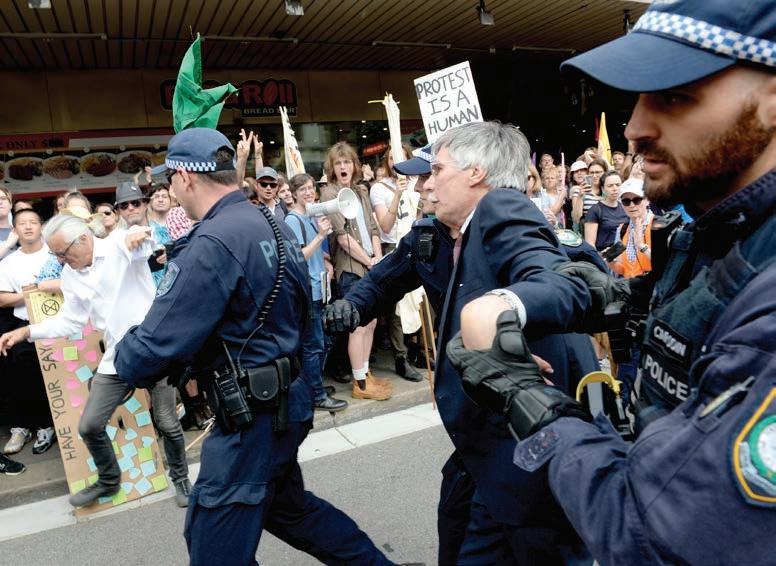
First Nations protest on Djab Wurrung Country
In western Victoria, government plans to build a highway extension through Djab Wurrung Country led to sustained protest by First Nations people and the community. The government’s plan involved potential disruptions to Djab Wurrung sacred cultural sites including important trees known as “directions trees”. More than 60 people were arrested in the course of the protests, several of whom are Aboriginal land protectors.88 A number of the protesters were removed, arrested and charged with failing to comply with the Chief Health Officer’s directions.89 These charges attracted fines of up to $5,000.90 Police also blocked access to the area, preventing lawyers and legal observers from entering, and there were reports that a protester’s arm had been broken.91 The actions of police raises questions about Victoria Police’s use of Covid-19 powers to arrest and charge protesters.92
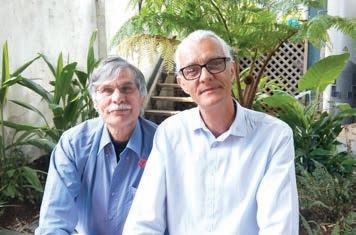
Disproportionate police use of force
In October 2019 at a climate change rally in Sydney a passerby, Benjamin Huie, came to the aid of an elderly gentleman who he believed to be in distress. Benjamin said “I saw riot squad police dragging an elderly gentleman by his wrists at what looked like an incredibly painful angle. He wasn’t resisting them at all but was clearly in distress and a lot of pain”. Mr Huie, who had been asked to leave the road area, said “I couldn’t just stand by and watch this peaceful protester be dragged away. He looked like he was having a heart attack. The man’s face was red and sweaty, his wrists were bent at an unnatural angle and the police were being really rough with him”. Mr Huie approached the gentleman with his hands held up and open and asked if he was okay. Mr Huie was arrested for approaching the gentleman, alongside dozens of other activists who engaged in the climate protest. Hr Huie has expressed concern that the police were using disproportionate force during the arrests in which “none of the people being arrested were resisting at all”.
28 29 Global Warning: the threat to climate defenders in Australia
Kirribilli House climate protest
Below: 13-year-old protester
©
Izzy Raj-Seppings reacts after police threaten to arrest her and other protesters during a protest outside of Kirribilli House in Sydney.
AAP
Right: Benjamin Huie (left, white shirt) falls as he is struck off balance by a police officer for going to the aid of Dr Martin Wolterding, 75, being removed by police in a painful submission technique known as a “compliance hold”.
©
AAP
Inset:
Dr Martin Wolterding and Benjamin Huie meet for the first time after an interview about their arrests.
© Nelli Stevenson
Stifling Civil Society
1
“We are seeing many governments around the world seeking to suppress the voices of civil society. The capacity for all citizens to raise concerns – even if we do not agree with them – is at the heart of strong and effective democracies. Defending the right of charities and other groups to publicly advocate our issues and concerns is critically important to our communities, our democracy, our country and our world.”
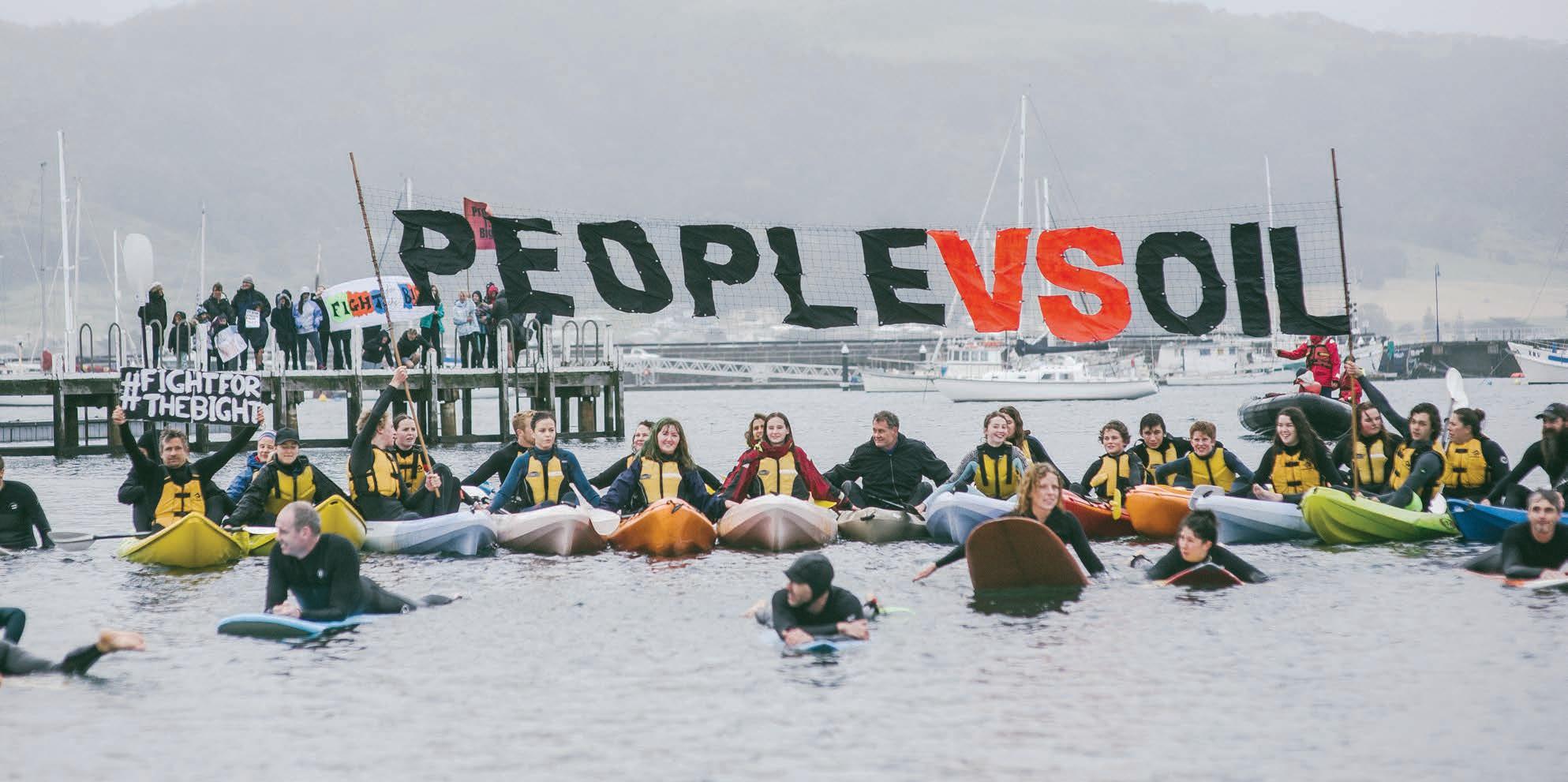
2
A number of Australian Government agencies have been captured by fossil fuel interests. This has resulted in the suppression of accurate information to the public about climate change risks, and has perpetuated the spread of climate change misinformation.
Reputable charities and not-for-profits who engage in climate change education and activism are an essential defence against such misinformation. However new electoral laws, proposed changes to the ACNC’s Governance Standards, and inappropriate pressure from political players is hampering the ability of these organisations to educate the public and advocate for stronger climate change policies in Australia.
A student-led flotilla including kayaks, sailboats, paddle boards, and surfboards set sail in Apollo Bay Harbour to send a message to oil companies that they are not welcome to drill in the Great Australian Bight © Sarah Pannell / Greenpeace
Reverend Tim Costello AO Chair of Community Council of Australia
Key summary
Defunding Climate Change Education
The federal government set up a Climate Commission in 2011 as a reliable, authoritative and independent source of information about climate change in Australia. In 2013, one day after the Coalition took government, it abolished the Climate Commission.93 An independent statutory body known as the Climate Change Authority continues to exist.
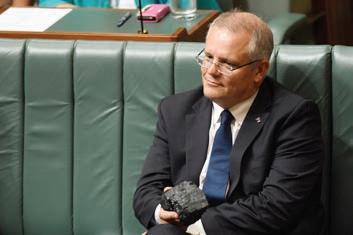
Unlike the Climate Commission which had a public education role, the Authority is designed to serve as the principal source of climate policy advice to the federal government. The Authority is legislated to have nine part-time members, including the Chief Scientist acting ex officio 94 It remains a dwindling institution in the Australian political scene following repeated attempts by the government to abolish the body, a number of high-profile resignations,95 and the federal government’s ongoing tendency to ignore its recommendations. The lack of an authoritative, government-funded body to provide public education on climate change is a disservice to the Australian people, who are frequently exposed to climate change misinformation.96
A number of Australian Government agencies have been captured by fossil fuel interests. This has resulted in conflicts of interest that stifle the flow of accurate information on climate change to the public. The Australian Government’s Bureau of Meteorology was paid around $4.6 million by gas giants Shell, Santos, Woodside and Chevron in the 2018/2019 financial year.97 Documents from the Bureau obtained via a freedom of information request show that references to climate change and long-term warming trends were removed during the drafting process from the Bureau’s public statements about the causes of the 2019 Black Summer bushfires.98
A 2020 survey showed that more than half (52%) of the environmental scientists surveyed who worked for Australian federal and state governments had been “prohibited from communicating scientific information”.99 In addition government respondents also reported inappropriate alteration of communications to paint government or industry actions or decisions in a misleading, more environmentally friendly light.100 The research found that “even internal communications were reported to be suppressed and modified, meaning that government ministers, senior managers, and corporate leaders might not receive frank information about the risks to biodiversity posed by their policies, decisions, and, ultimately, actions”.101 Reputable charities and not-for-profits who engage in climate change education and activism are an essential defence against such misinformation, but they too have come under attack.
including
Australia, St Vincent de Paul Society National Council of Australia, The Benevolent Society, Alliance for Gambling Reform, the ACT Council of Social Service, Public Health Association of Australia and Catholic Social Services protested outside Parliament House on 4 August 2021 when the proposed ACNC Governance Standard 3 changes were introduced into
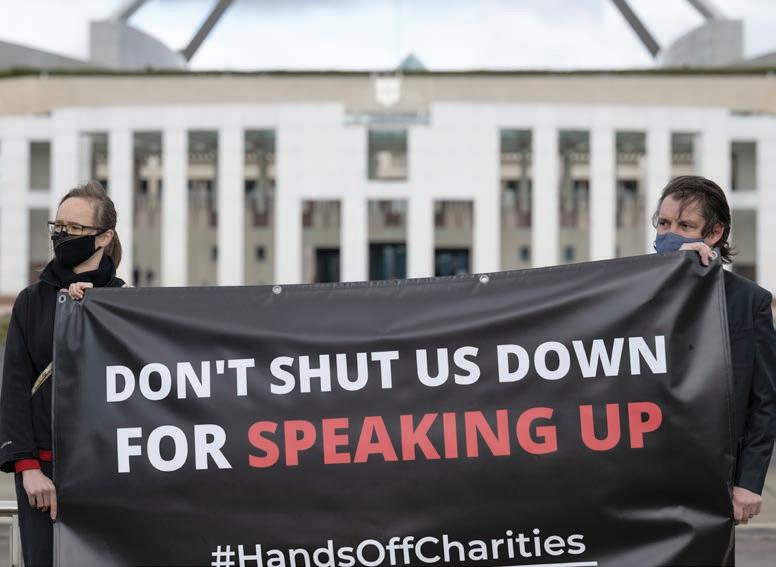
Threatening Charities who Engage in Climate Activism with Deregistration
There are approximately 600,000 not-for-profits in Australia.102 Around 56,000 of these are charities registered with the Australian Charities and Not for Profits Commission (ACNC).103
Registration under the Australian Charities and Not-for-Profits Commission Act 2012 (Cth) is a necessary precondition for access to a range of exemptions, benefits and concessions, including certain Commonwealth tax concessions.
In order to remain registered with the ACNC, charities must comply with the ACNC’s Governance Standards. The federal government has proposed changes to Governance Standard 3 which could see charities deregistered for minor and inadvertent acts.104
The changes would significantly expand the offences upon which the ACNC Commissioner could deregister a charity. This would include an employee committing minor offences such as:
– entering, remaining on, damaging or appropriating property or
– threatening or causing personal injury or any other kind of impairment.
Charities are already prohibited from engaging in such offences. These changes mean that charities would not only face existing punishments but could also face deregistration of the entire charity if an individual employee engages in such conduct, even if the charity did not condone or have knowledge of the offence.
If the changes proceed, the ACNC Commissioner will be able to deregister a charity if it fails to maintain ‘‘reasonable internal control procedures’’, or to document the steps taken to ensure that its resources (including employees, funds, premises, websites and social media accounts) are not used to ‘‘actively promote’’ an employee committing one of these minor offences. This means charities could be deregistered for lawful activity, like tweeting in support of a climate change rally where a protester peacefully steps on private land, or for providing a meeting room to a community group who use it to plan a sit-in at Parliament House.
32 33 Global Warning: the threat to climate defenders in Australia Stifling Civil Society
Right: Leaders of Canberrabased charities
Anglicare
the Senate.
©Martin Ollman / HOOCs
Inset:
Prime Minister Scott Morrison holds a piece of coal during House of Representatives Question Time at Parliament House in Canberra in February 2017.
© AAP
Stifling

“In these unsettling and unprecedented times, charities are needed more than ever to ease the burdens faced and to bear witness to the struggles of the vulnerable. It’s truly alarming that in the midst of this crisis, the government proposes regulations which are undeniably aimed at shutting down dissent and silencing charities. Citizens engage in and support protest action the world over for the purpose of achieving social outcomes. Protest action provides citizens with visually powerful and effective ways of drawing public attention towards achieving real change to improve civil society. Charities have a long and proud history of engaging in protest action as part of an extended tradition of peaceful and non-violent protest and persuasion that is a valued part of Australia’s democratic system. It is for this precise reason that the proposed amendments to Governance Standard 3 are likely unconstitutional, as they impose an effective burden on the implied freedom of political communication. We know from recent High Court authority that a “law which prohibits or limits political communication to any extent will generally be found to impose an effective burden on the implied freedom of political communication”, and that the implied freedom is effectively burdened by deterring protesters “from voicing their protests”.”
Peter Seidel, Partner, Arnold Bloch Leibler
2021 press conference outside Parliament House where the leaders of prominent Australian charities gathered to oppose the new changes to Governance Standard 3.
Ollman
Concerningly, the proposed amendments will allow the ACNC Commissioner to deregister a charity even if it has not been charged or found guilty of an offence. A charity could be deregistered simply because the ACNC Commissioner forms the subjective view that it is “more likely than not” that the charity will not comply with the governance standard in the future,105 or because the charity failed to keep documentation proving its compliance with these new requirements.
There is a high level of consensus amongst legal commentators that the government does not have the power to make these regulations under the Australian Charities and Not-for-Profits Commission Act and that the second limb of these proposed changes (that a charity cannot use its resources to actively promote another person’s act which may be dealt with as one of the minor offences) is unconstitutional.106
The changes unfairly target charities in a way which is unparalleled in the private sector. They place an unreasonable and discriminatory burden on the sector. No rational justification has been given for why existing regulation is insufficient.
The charity sector has voiced outrage at the proposed changes arguing that they are disproportionate, punitive, lack transparency and fairness, and would add an expensive administrative burden on charities. Recent independent modelling by economic consulting firm ACIL Allen revealed that the sector implementation cost of the changes may be up to $150 million in their first year alone, dwarfing the $1.4 million cost estimate Assistant Treasurer Michael Sukkar forecast in the explanatory statement on the changes.
President of the Law Council of Australia Jacoba Brasch says the changes would “leave registered charities, including faith-based charities, at grave risk of political interference”.107 Legal experts Arnold Bloch Leibler believe the changes are “fundamentally inconsistent with our democratic system of government”.108 Some of the infractions which could spark deregistration are so minor in nature that they could easily be weaponised against charities who raise genuine concerns about government policies in order to silence dissent. Moreover if the changes proceed, the added risk is likely to stop charities from sharing their resources with grassroots and community groups to support their advocacy, and will discourage charities from promoting and having a presence at common peaceful protests.
Advocacy is an essential tool used by charities to achieve their charitable purpose in a democracy. Minister Sukkar said “the Morrison Government is strengthening laws to ensure activist organisations, masquerading as charities, that promote and engage in unlawful behaviour will no longer be tolerated”.109 Protest action is not synonymous with unlawful activity. However, given the abundance of potential minor offences that can be unwittingly committed at a lawful gathering of people in protest and the increasing criminalisation of protest activities (as previously outlined in this report) the proposed regulatory changes will make all protest action an untenable risk for registered charities.
Minister Sukkar gave charities less than a month to provide submissions regarding these concerning changes. The Minister lodged the regulations in Parliament and continues to support them despite the Senate Standing Committee for the Scrutiny of Delegated Legislation raising serious concerns about the impact these proposed regulations would have on the implied constitutional freedom of political communication. Both this Committee, and Senator Rex Patrick have each called votes to reject the changes, votes which had not yet taken place at the time of writing this report. Many critics have voiced concern that should these changes proceed, they would fundamentally change the role of the charitable regulator and significantly expand its powers beyond the remit granted by parliament at its inception.
34 35 Global Warning: the threat to climate defenders in Australia
Civil Society Left:
©Martin
Attempts to Stop Charities from Engaging in Climate Activism
Over the years the federal government has made repeated attempts to stop charities from engaging in political activism. In Aid/Watch Inc v Federal Commissioner of Taxation110 the High Court recognised advocacy and political activity as vital to the work of charities in Australia. It reasoned that public debate is a purpose that is beneficial to the community and that political communication is essential for maintaining Australia’s system of responsible and representative government. In its unanimous judgment in Lange v Australian Broadcasting Corporation, 111 the High Court stated that “[f]reedom of communication on matters of government and politics is an indispensable incident of the system of representative and responsible government which the [Australian] Constitution creates and requires”.112
Political advocacy by charities enriches the political process by encouraging debate about matters affecting government, politics and policies, facilitating citizen participation and engaging and promoting political pluralism.113 Parliament enshrined the High Court’s comments in Aid/Watch in the Charities Act 2003 (Cth), which notes at 12(l) that charitable purpose includes “the purpose of promoting or opposing a change to any matter established by law, policy or practice in the Commonwealth, a State, a Territory or another country” if the change is in furtherance of, or in opposition to, one or more other charitable purposes. The explanatory memorandum to the Charities Act recognises that this provision protects the right to freedom of expression and the right to take part in public affairs.114
It is ultimately not possible to effectively protect the environment without engaging in advocacy. While on-the-ground activities by environmental organisations are important, they can be rendered largely ineffective if they are not complemented by policy change. For example, on-the-ground conservation of intact ecosystems or biodiversity (like planting trees) will be ineffective in the long-term unless there is effective policy action on climate change.
It is a well-established principle in Australian law that a charity can, and indeed should, engage in advocacy or political activity in pursuit of its charitable purpose.115 A distinction must be drawn here. A registered charity cannot promote or oppose a political party or candidate.116 It can however advocate on public policy issues such as climate change. Despite this position at law, charities who engage in issues-based climate activism are routinely criticised by government officials for their legitimate engagement in the political process.
The threat of deregistration
Politicians regularly use the threat of deregistration in an attempt to silence climate activism charities who speak out against their policies. In April 2021 Tasmania’s Resources Minister Guy Barnett wrote to federal Assistant Treasurer Michael Sukkar requesting he strip the Bob Brown Foundation of its charitable status after the foundation placed an advertisement in the Hobart Mercury newspaper urging people to “green your vote” in an upcoming state election. Dr Brown clarified “we want Tasmanians to vote for any candidates, Greens included, who advocate an end to native forest logging and clearfell napalming of this island’s magnificent forests”.117
Right and inset: Students and supporters protest outside Labor MP for Grayndler Anthony Albanese’s Office in Marrickville, Sydney, against the Australian government’s inaction on climate change and the Adani coal mine in 2019. The action was part of the Fridays for Future and Youth Strike 4 Climate movements.
© Genevieve French Greenpeace

In recent years electoral laws have been introduced federally and in a number of states which place an enormous administrative burden on charities that undertake public interest, issues-based advocacy in the lead up to an election. These poorly drafted electoral laws often place resource intensive administrative obligations on such charities, requiring them to reallocate scarce resources away from their charitable work. For instance, the onerous compliance regime in NSW requires charities to disclose donations of as little as $1,000 p.a. (or less than $20 per week), and prohibits them from accepting donations over $3,000 p.a. for use on advocacy that “indirectly” influences voting in a NSW state election. The complexity and overreach of the regime discourages and, in some cases entirely prevents, charities from advocating for stronger climate change policies in the lead up to an election in NSW.
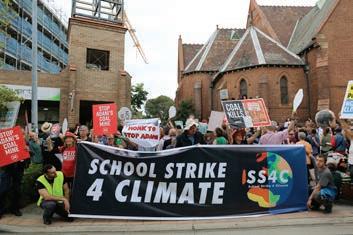
Supporting the school climate strikes
In a conference held under the Chatham House Rules, a number of registered charities expressed concern that the charitable regulator, the Australian Charities and Not-for-profits Commission (ACNC) was pressuring them not to provide support for, or to promote, the School Strike 4 Climate as the charity could be seen as supporting unlawful activity, given that the children were striking from school. Representatives from these charities said they were told that if they supported or promoted the School Climate Strikes they would be risking deregistration and could potentially lose the taxation benefits associated with it.
36 37 Global Warning: the threat to climate defenders in Australia
Civil Society
Stifling
Targeting Activism with Litigation
“The simple fact of the commencement of a SLAPP suit has an untold chilling effect on the defendant and the broader community. They are long, costly and daunting. They threaten the defendant with millions in damages and legal costs. But the plaintiff will rarely (if ever) recover that money, even if they won the case. And by the time the action is commenced, the targeted activists have generally switched tactics. So what must be the point of a SLAPP suit? At the very least it is to send a message to activists: take us on and you could face personal ruin. That poses a very significant threat to the future of climate activism.”
Kiera Peacock Partner, Marque Lawyers & lawyer for Ben Pennings
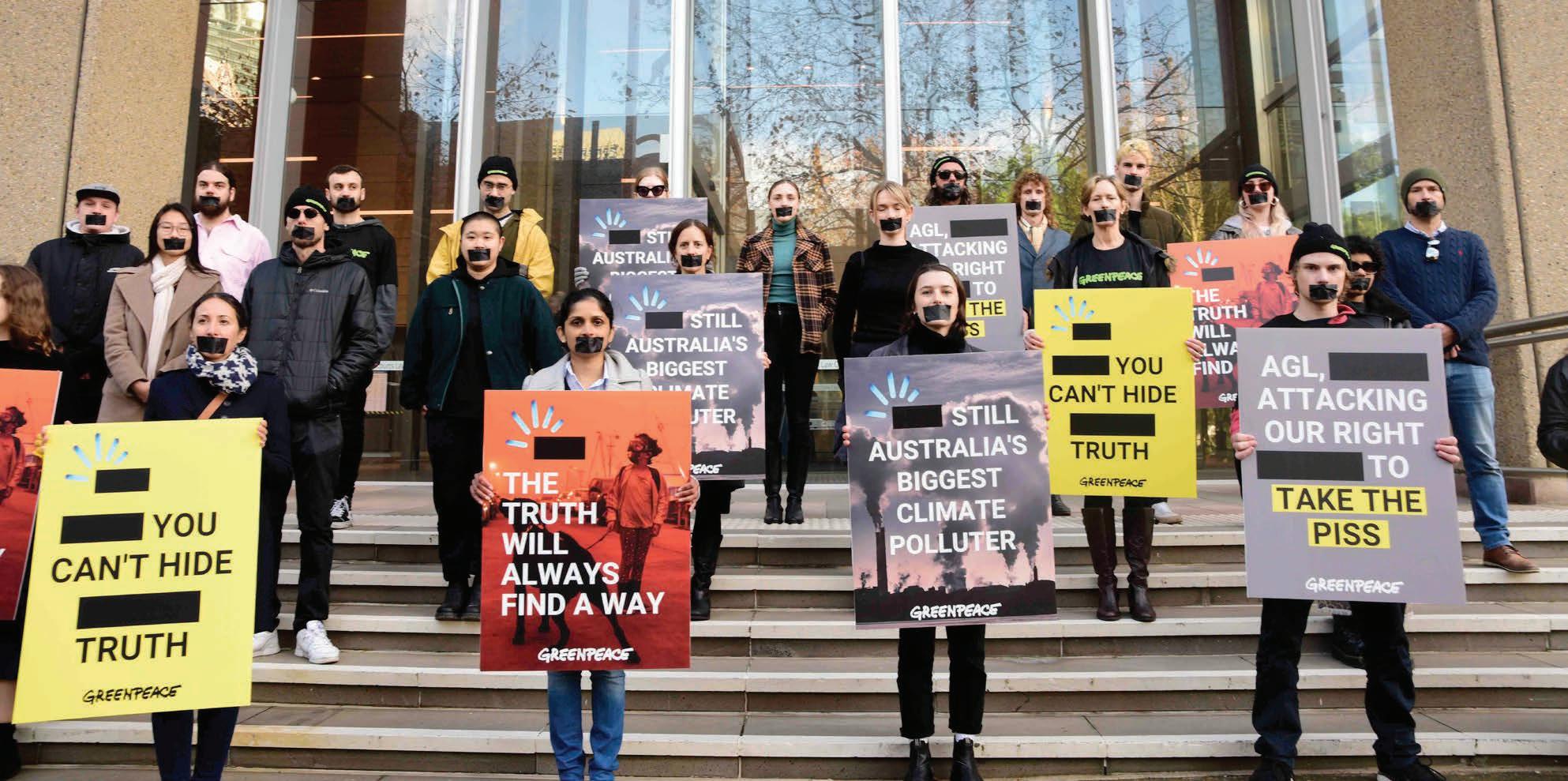
Key summary
1
2
Strategic lawsuits against public participation (SLAPPs) are used as a tool in an attempt to silence climate activists.
Corporations are increasingly pursuing climate activists for claims of compensation and/or restitution resulting from loss to business activities as a result of protest action.
A crowd of activists gather outside the Federal Court of Australia in Sydney on the day of the 2021 AGL v Greenpeace hearing in support of Greenpeace’s right to freedom of expression. © James Zadro / Greenpeace
Targeting Activism with Litigation
Strategic lawsuits against public participation (SLAPPs) are legal actions brought against particular groups or people to silence them by burdening them with the cost of litigation.
Not all SLAPPs are frivolous or vexatious. SLAPPs are lawsuits which may have a valid cause of action but which are taken with the intent of restricting public participation (as opposed to protecting legitimate interests).
Corporations have used SLAPPs in Australia to silence environmental activists, such as the Tasmanian logging company Gunns,118 which filed a $6.3 million lawsuit against environmentalists who opposed its logging operations.
The following case studies are recent legal actions which are viewed by many within the environmental sector as SLAPPs.
The SLAPP against Ben Pennings
In Queensland, activist Ben Pennings is being sued by Bravus (formerly Adani) for his activism in relation to the Adani-Carmichael coal mine. The claim is for amongst other things, damages for intimidation and conspiracy, and injunctions with respect to the use of confidential information and inducing breaches of contract. Lawyers for Bravus told a Queensland court they did not know what confidential information “if any” had been obtained by Mr Pennings, who was being sued by the company for breach of confidence at the time.119 Two attempts were made by Adani for a search order of Mr Pennings’ home and personal belongings. Both were refused by the Court. However, Adani has been successful in an interlocutory injunction compelling the activist to remove material from social media accounts and restrain him from publishing certain statements, seeking to induce or procure any person to disclose particular information to him, and from using confidential or other information obtained by him for his campaigns. This matter is ongoing.120
The weaponising of intellectual property rights
In March 2021 environmental charity
Greenpeace Australia Pacific (Greenpeace) published an investigative report and launched an accompanying campaign calling coal mining giant AGL out as “Australia’s Biggest Climate Polluter”. AGL’s marketing materials represented the company as a leader in the transition to renewable energy despite the company being responsible for 8% of Australia’s domestic carbon emissions, and renewables accounting for only around 10% of AGL’s total electricity output at the time.121 Greenpeace published parodies of AGL’s advertisements with the headline claim “Still Australia’s Biggest Climate Polluter” to show the dissonance between the company’s advertising and its activities. AGL launched legal action against Greenpeace demanding that the charity remove any identifying AGL logos from its campaign. It argued that the parodies infringed copyright and trademark. It requested an urgent interlocutory injunction to have the materials which included versions of the AGL logo removed.
These types of cases weaponise intellectual property rights in an attempt to suppress speech and stifle criticism.122 AGL’s request for an urgent interlocutory injunction was refused by the Federal Court. The Court determined that Greenpeace had not breached AGL’s trademark, and that the vast majority of Greenpeace’s campaign materials were protected by a freedom of speech safeguard in the Copyright Act known as fair dealing. AGL was on notice that Greenpeace would be relying on these defences before launching proceedings. AGL was ordered to pay a substantial portion of Greenpeace’s legal costs.
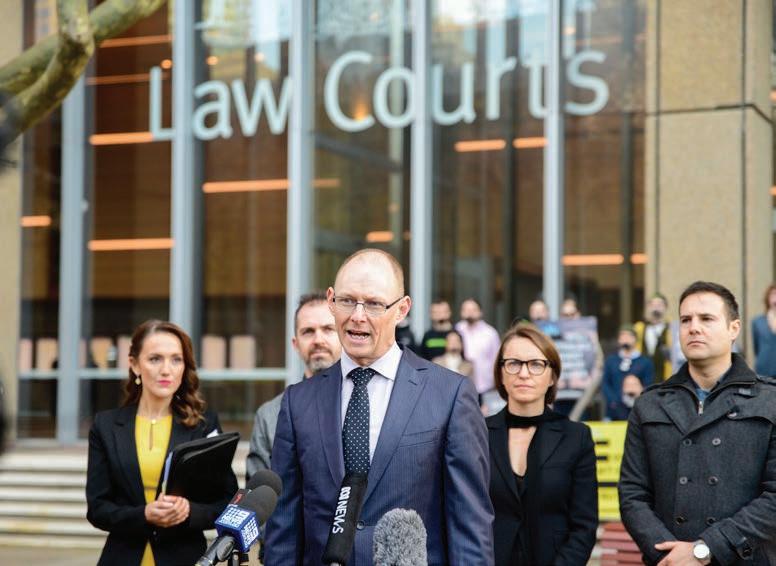
There has been a demonstrated practice throughout Australia for claims of compensation and/or restitution resulting from loss to business activities due to protest action. These claims have been pursued not through the civil courts, but through victim compensation legislation that arises from criminal matters.123 Cases in the NSW Local Court highlight that victim compensation is not limited to individuals, and large wellresourced corporations can claim under the scheme, albeit difficult to quantify the loss.124 If large corporations pursue these avenues, they will attempt to make environmental activists liable for any quantifiable loss to the business flowing from the conduct deemed criminal. These losses can be in the hundreds of thousands of dollars.125 This seriously threatens climate activism by perpetuating the already stark power imbalance between corporations and activists and deterring climate defenders.
The case against Greg Rolles In November 2018 climate activist Greg Rolles from Christian Climate Action Australia, alongside other activists from Front Line Action on Coal, suspended himself in a bamboo tripod erected over a railway line used to transport coal to the Abbot Point terminal. The terminal is owned by Indian mining company Bravus (formerly known as Adani), a company which was preparing to open a new coal mine which analysts feared would have major detrimental impacts on Australia’s Great Barrier Reef. Rolles was charged with three counts including trespass. He unsuccessfully attempted to argue the “extraordinary emergency” defence which renders people not criminally liable if they were acting in response to a sudden or extraordinary emergency. Rolles was fined $7,000 and ordered to pay $2,233 to the country’s rail freight operator Aurizon. In addition, Aurizon initiated proceedings against Rolles seeking $75,000 in damages.126
40 41 Global Warning: the threat to climate defenders in Australia
Right: Greenpeace Australia Pacific’s CEO David Ritter speaks to the press on the steps of the Federal Court before the AGL v Greenpeace hearing.
© James Zadro / Greenpeace
Corporate Surveillance and Direct Infiltration

Key summary
1
2
3
Australian governments and fossil fuel corporations have a history of engaging in surveillance and the direct infiltration of charities, not-for-profits and grassroots organisations who organise strikes, demonstrations, or other public forms of protest (often referred to as direct action).
The corporations and governments who engage in the surveillance and infiltration of Australian climate activist groups are rarely held to account.
The growing, and largely unregulated use of facial recognition software and metadata information infringes on the right to privacy and freedom of association of climate activists.
Greenpeace climbers in the trees on the second day of the occupation of Leard State Forest preventing the clearing of the forest for Whitehaven’s Maules Creek Coal Mine. Police ascend in a cherry picker and remove food, water and sleeping equipment from the activists. © Greenpeace
Corporate Surveillance and Direct Infiltration
In Australia corporations and governments who engage in the surveillance and infiltration of Australian climate activist groups are rarely held to account. In particular, climate activists in Australia are concerned about the growing, and largely unregulated use of facial recognition software and metadata information. The prospect of surveillance and the potential for protesters to be included in law enforcement databases as a result of peaceful, law-abiding protest activities violates the right to privacy and is likely to deter protesters from exercising their freedom of association and expression through public protests.
Deakin University cybersecurity expert Dr Monique Mann warns that protesters should expect Australian police to use facial recognition technology while policing protests.127 Such technology was trialled by state police during the Commonwealth Games, used at Lang Park which is the location of the State of Origin, and by Perth City Council.128 Dr Mann notes that “at the moment we have no information about this and no oversight”.129 Amnesty International AI and Human Rights Researcher Matt Mahmoudi has raised concerns that “facial recognition risks being weaponised by law enforcement against marginalised communities around the world”.130 The Australian Government Office of the Australian Information Commissioner launched an investigation into the information handling practices of Clearview AI Inc., focusing on the company’s use of “scraped” data and biometrics,131 after it was revealed that the facial recognition app company had previously sold data to the Queensland, South Australian and Victorian police.132 The facial recognition app combines machine learning and wide-ranging data-gathering practices to identify members of the public from online photographs.
Similar concerns have been voiced regarding the use of metadata which is being retained in accordance with Part 5-1A of the Telecommunications (Interception and Access) Act 1979 (Cth). Legal experts have recommended scaling back mandatory data retention laws, which currently require telecommunication companies to keep records of every Australian’s text messages, phone calls, internet browsing history, and a range of other data for at least two years. This data has been accessed over 350,000 times a year by at least 87 different agencies.133 The Parliamentary Joint Committee on Intelligence and Security has made a number of recommendations regarding the controversial laws, including amending the law so that people’s data can only be accessed by specified security and law enforcement agencies in connection with serious crimes, as well as ensuring there is improved recording keeping and oversight of when the data is accessed and how it is used. Senior Lawyer Alice Drury from the Human Rights Law Centre said “the current regime allows law enforcement bodies to watch everybody, all of the time. These laws were meant to prevent serious crime, but in reality they have been used to investigate journalists, and by local councils to chase down litterbugs. It allows mass surveillance without any of the necessary safeguards to protect our fundamental rights to privacy”.134
There have also been documented instances of fossil fuel industry corporations utilising the services of investigative firms specialising in the systematic surveillance of peaceful climate activism groups.
Infiltrating a climate camp
In 2014 a climate activist camp was erected near the Maules Creek and Boggabri coal mine construction sites in NSW. The climate activists, known as the Leard Forest Alliance or Front Line Action on Coal, had been protesting for three years against the expansion of coal mining in the area by Japanese mining giants Idemitsu and Whitehaven Coal. According to an investigative report by Nine, for five months former intelligence and military personnel took on assumed identities with elaborate backstories. They rotated through the camp, taking notes, reporting back on any planned actions and profiling the camp’s leadership.135
One of the camp coordinators, Ben Solity, says the operatives would suggest protest actions that were highly risky and potentially damaging to the cause, they would find ways to disrupt the protest activities and sow seeds of division and mistrust amongst the group. The undercover operatives were discovered and linked to a number of intelligence companies including the Centre of Intelligence and Risk Management (CIRM). According to the Nine report, CIRM employed the operatives and its senior figure, Tony Groves, reported to a former Australian Federal Police officer, whose company C5 Management Solutions received the intelligence and provided reports to Idemitsu. Idemitsu admitted it had contracted intelligence organisations including C5 Management Solutions but denied knowledge of the surreptitious practices used to obtain the information.
Adani’s ‘trained attack dog’
In 2019 documents were leaked from a law firm employed by mining giant Bravus (formerly Adani). In the documents the law firm AJ & Co promises to be Adani’s “trained attack dog”.136 It recommends strategies to bankrupt individuals and wind-up organisations who unsuccessfully challenge the mining company in court. It recommends using the legal system to pressure government decision makers and employing tactics to silence activists including taking civil action against protesters, hiring private investigators to target activists and using social media as a tool to discredit activists who oppose Adani’s operations.
The above stories are not isolated. Anecdotal evidence suggests that climate activists are often followed by people believed to be plain-clothed operatives.
In 2009, former Attorney General Robert McClelland admitted in a letter to former Resources Minister Martin Ferguson that the Australian Federal Police “continually monitors the activities of issues-motivated groups and individuals who may target establishments through direct action”.137
Project Caesar
In 2019, an investigation conducted by The Guardian revealed that mining company Glencore has spent millions of dollars on a covert project known as “Project Caesar” –“a globally coordinated campaign to prop up coal demand by undermining environmental activists, influencing politicians and spreading sophisticated pro-coal messaging on social media”.138 As part of the project the company collected intelligence about key coal detractors, “including Greenpeace and 350.org, detailing their budgets, social media reach, and issues that could be used to embarrass or undermine them”.139
44 45 Global Warning: the threat to climate defenders in Australia
Recommendations
A. Strengthen Australia’s Democracy
1
Enact legislation to strengthen political integrity and reduce the distorting influence of the fossil fuel industry in Australia’s democracy.
The key reforms needed are set out in the Framework for a Fair Democracy,140 endorsed by 30 Australian civil society and environment organisations. Reforms include establishing a federal integrity commission, increasing transparency around political donations and imposing political donation caps and spending limits.

Left: The “Say Yes” coalition of environmental non-government organisations tether a hot air balloon on the lawn of Parliament house in 2011 after Australia passes the Carbon Tax through the lower house of Parliament. In 2014 the Carbon Tax was repealed.
© Belinda Pratten Greenpeace
B. Strengthen Legal Protections for Activism
1
Introduce an Australian Charter of Human Rights141 which:
– Enshrines the rights to freedom of association and freedom of peaceful assembly;
– Ensures governments consider people’s human rights when creating new laws and policies; and
– Provides people with an avenue for recourse if their rights are violated. Australia is the only Western democracy in the world without a Charter of Rights, or equivalent legal protections. Rights such as freedom of association and assembly cannot be adequately safeguarded against threats and repressive laws without this baseline protection. A Charter also allows for the recognition of other rights, such as the right to a healthy environment.
2
Build stronger defences for activism in the law and recognise the ‘emergency climate defence’ as a statutory defence for environmental activism. This defence, based on the common law defence of necessity, permits law breaking in the case of a “sudden or extraordinary emergency” if the act undertaken is a reasonable way to deal with the emergency and proportionate to the emergency faced.142 It can be used to remove liability for criminal conduct in certain circumstances.143
Statutory reform that recognises climate change as a sudden or extraordinary emergency would create greater protections for individuals who have been charged with criminal offences as a result of their activism. It would enable them to utilise this defence in appropriate circumstances, with the Court having to consider whether their actions were a reasonable way to deal with the emergency and a proportionate response to the emergency as perceived.
3
4
Greater oversight for police-imposed bail conditions that sees an independent third body, such as a Registrar of the Local Court, reviewing police-imposed bail on environmental activists to ensure that such conditions are appropriate and do not unjustly limit freedoms of association and assembly.
Withdraw the proposed changes to Charities Governance Standard 3 which would have a chilling effect on freedom of speech in Australia and hamper the ability of charities to fulfil their charitable purpose, support activism and continue their important public interest work.
46 47 Global Warning: the threat to climate defenders in Australia
Endnotes
1 Universal Declaration of Human Rights, GA Res 217A (III), UN GAOR, UN Doc A/810 (10 December 1948).
2 International Covenant on Civil and Political Rights, opened for signature 16 December 1966, 999 UNTS 171 (entered into force 23 March 1976), see Article 19 (freedom of expression) and Article 20 (right to peaceful assembly).
3 See Nationwide News Pty Ltd v Wills (1992) 177 CLR 1; Australian Capital Television Pty Ltd v The Commonwealth (1992) 177 CLR 106; Unions NSW v New South Wales [2013] HCA 58.
4 Paris Agreement, opened for signature on 22 April 2016, ATS 24 (entered into force 4 November 2016) art 2. See also United Nations Framework Convention on Climate Change, opened for signature 3 June 1992, 1771 UNTS 107 (entered into force 21 March 1994) art 2.
5 Jan Burck et al. Climate Change Performance Index 2021 (Annual index, 7 December 2020) 7 <https:// ccpi.org/download/the-climate-change-performanceindex-2021/>.
6 Natasha Kassam, Lowy Institute Poll 2020 (Annual poll, June 2020) 5
7 Staff and agencies, ‘Scott Morrison denounces ‘green criminals’ as vegan protests block Melbourne CBD’, The Guardian (online, 8 April 2019) <https://www. theguardian.com/world/2019/apr/08/animal-rightsactivists-block-melbourne-cbd-amid-protests-atabattoirs-around-australia>.
8 Staff and agencies, ‘Scott Morrison denounces ‘green criminals’ as vegan protests block Melbourne CBD’, The Guardian (online, 8 April 2019) <https://www. theguardian.com/world/2019/apr/08/animal-rightsactivists-block-melbourne-cbd-amid-protests-atabattoirs-around-australia>.
9 Joana Setzer and Catherine Higham, ‘Global trends in Climate Change Litigation: 2021 Snapshot’ (Policy Report, Grantham Research Institute on Climate Change and the Environment, Centre for Climate Change Economics and Policy, Columbia Law School, July 2021) <https://www.lse.ac.uk/granthaminstitute/publication/ global-trends-in-climate-change-litigation-2020snapshot/>.
10 Paul Karp, ‘Coalition warned outlawing climate boycotts could breach constitution‘ The Guardian (online, 5 November 2019) <https://www.theguardian.com/ world/2019/nov/05/coalition-warned-outlawing-climateboycotts-could-breach-constitution>.
11 Adam Morton, ‘Great Australian Bight: Equinor abandons plans to drill for oil’, The Guardian (online, 25 Feb 2020 <https://www.theguardian.com/environment/2020/feb/25/ great-australian-bight-equinor-abandons-plans-to-drillfor-oil>.
12 Market Forces, ‘ANZ commits to exit thermal coal, but rewards climate-destructive companies’, Banktrack (Web Page, 29 October 2020) <https://www.banktrack.org/ article/anz_commits_to_exit_thermal_coal_but_rewards_ climatedestructive_companies#_>.
13 Greenpeace Australia Pacific, ‘ReEnergise Rankings’ (Web Page, 17 May 2021) <https://reenergise.org/ rankings/>.
14 ‘School Strike 4 Climate’, Home (Web page, 2021) <https:// www.schoolstrike4climate.com/>.
15 [2021] FCA 560.
16 Luke Henriques-Gomes et al, ‘Hundreds of thousands attend school climate strike rallies across Australia’, The Guardian (online, 20 September 2019) <https://www. theguardian.com/environment/2019/sep/20/hundreds-ofthousands-attend-school-climate-strike-rallies-acrossaustralia>.
17 Rebecca Hewett, ‘Should you let your kids skip school to be part of a political protest?’ ABC News (online, 29 November 2018) <https://www.abc.net.au/ news/2018-11-29/should-kids-be-part-of-activism-andprotests/10566178>.
18 Australian Bureau of Statistics, ‘Wilcannia’, 2016 Census Quickstats (Web Page, 23 October 2017) <https://quickstats.censusdata.abs.gov.au/ census_services/getproduct/census/2016/quickstat/ SSC14290?opendocument>.
19 Sofie Wainwright and Aimee Volkofsky, ‘Drying up of the Darling River angers community, sparks second protest’, ABC News (online, 1 April 2018) <https://www.abc.net. au/news/2018-04-01/drying-up-darling-river-angerscommunity-sparks-protest/9608644>.
20 Hannah Forsyth, ‘The Barkindji people are losing their ‘mother’, the drying Darling River’, The Conversation (online, 4 May 2016) <https://theconversation.com/thebarkindji-people-are-losing-their-mother-the-dryingdarling-river-57884>.
21 Sofie Wainwright, ‘Indigenous protesters march to show their anger over the drying up of the Darling River’, ABC News (online, 20 June 2018) <https://www.abc.net.au/ news/2016-06-20/indigenous-protesters-protest-overstate-of-darling-river/7526718>.
22 Sofie Wainwright and Aimee Volkofsky, ‘Drying up of the Darling River angers community, sparks second protest’, ABC News (online, 1 April 2018) <https://www.abc.net. au/news/2018-04-01/drying-up-darling-river-angerscommunity-sparks-protest/9608644>.
23 Rachel Evans, ‘Wilcannia Bridge closed off as protesters fight to save Darling River and Menindee Lakes’, Green Left (online, 13 March 2020) <https://www.greenleft. org.au/content/wilcannia-bridge-closed-protestersfight-save-darling-river-and-menindee-lakes>; Water for Rivers, ‘Defend water warriors: Leah Ebsworth and others’, Go Fund Me (Web Page, 9 April 2021) <https:// www.gofundme.com/f/defend-water-warriors-leahebsworth-others?utm_campaign=p_cf+share-flow-1&utm_ medium=copy_link&utm_source=customer>.
24 Mikele Syron ‘Traditional Owner fronts court for anti-fracking protest’, NITV News (online, 21 October 2020), <https://www.sbs.com.au/nitv/article/2020/10/21/ traditional-owner-fronts-court-anti-fracking-protest>.
25 Wangan and Jagalingou Family Council, ‘Stop Adani destroying our land and culture’, Our Fight (Web Page) <https://wanganjagalingou.com.au/our-fight/>; Ben Smee, ‘Access to Adani’s Carmichael coal mine in Queensland blocked by traditional owners’, The Guardian (online, 24 August 2020) < https://www.theguardian.com/ environment/2020/aug/24/adanis-carmichael-coalminein-queensland-blocked-by-traditional-owners>.
26 Tour de Carmichael, ‘Wangan & Jagalingou Traditional Owners invite you’, Tour de Carmichael – Cycle for Country (Web Page) <https://tourdecarmichael.wixsite. com/cycle>.
27 Michael West and Simone Marsh, ‘Dirty Power: Big Coal’s Network of Influence Over the Coalition Government’ (Investigative Report, Greenpeace Australia Pacific, May 2019) <https://apo.org.au/sites/default/files/ resource-files/2019-05/apo-nid258826.pdf>.
28 Australian Conservation Foundation, ‘Fossil Fuel Money Distorting Democracy’ (Report, Australian Conservation Foundation, February 2020). <https://d3n8a8pro7vhmx. cloudfront.net/auscon/pages/17065/attachments/ original/1605244960/Fossil_fuel_money_distorting_ democracy.pdf?1605244960>.
29 Clive Palmer’s own company, Mineralogy, donated around $83.7 million to Palmer’s own party, the United Australia Party.
30 See Danielle Wood and Kate Griffiths, ‘Who’s in the Room: Access and Influence in Australian Politics’ (Report, The Grattan Institute, 23 September 2018).
31 McCloy v New South Wales [2015] HCA 34, [36] (French CJ, Kiefel, Bell, Keane JJ).
32 For a breakdown on how special interest groups convert economic power into political power, see Danielle Wood and Kate Griffiths, ‘Who’s in the Room: Access and Influence in Australian Politics’ (Report, The Grattan Institute, 23 September 2018).
33 Australian Conservation Foundation, ‘Fossil Fuel Money Distorting Democracy’ (Report, Australian Conservation Foundation, February 2020) 6.
34 Australian Conservation Foundation, ‘Fossil Fuel Money Distorting Democracy’ (Report, Australian Conservation Foundation, February 2020) 4.
35 Centre for Public Integrity, ‘Australia’s weak donation laws allowed $1bn in dark money to go to political parties over two decades’, (Media Release, 1 February 2021) <https://publicintegrity.org.au/australias-weak-donationlaws-allowed-1bn-in-dark-money-to-go-to-politicalparties-over-two-decades/>.
36 Government of Western Australia, ‘Gas Industry’ (Web page) <https://www.wa.gov.au/organisation/energypolicy-wa/gas-industry>.
37 APPEA, ‘Green tape reform a top priority for oil and gas industry’ (Media Release, 14 July 2020); APPEA, Cutting Green Tape (Report, February 2013).
38 APPEA, Submission No 28 to House of Representative Standing Committee on Economics, Inquiry into Impediments to Business Investment in Australia (25 May 2018) 17.
39 350 Boorloo Perth, ‘Captured State: The influence of the gas lobby on WA’ (Report, 350.org, December 2020) 3-4 <http://350perth.org.au/captured-state/>.
40 350 Boorloo Perth, ‘Captured State: The influence of the gas lobby on WA’ (Report, 350.org, December 2020) 3-4 <http://350perth.org.au/captured-state/>.
41 350 Boorloo Perth, ‘Captured State: The influence of the gas lobby on WA’ (Report, 350.org, December 2020) 10 <http://350perth.org.au/captured-state/>.
42 350 Boorloo Perth, ‘Captured State: The influence of the gas lobby on WA’ (Report, 350.org, December 2020) 11 <http://350perth.org.au/captured-state/>.
43 350 Boorloo Perth, ‘Captured State: The influence of the gas lobby on WA’ (Report, 350.org, December 2020) 16 <http://350perth.org.au/captured-state/>.
45 Market Forces, ‘Australia’s major political parties, brought to you by fossil fuels!’ (Web page, February 2020) <https:// www.marketforces.org.au/politicaldonations2020>.
46 Nicolas Perpitch, ‘EPA scraps new carbon emissions guidelines for resources companies amid industry pressure’, ABC News (online, 14 March 2019) < https://www.abc.net.au/news/2019-03-14/epa-scrapscarbon-emssions-guidelines-for-wa-resourcesprojects/10901574>.
47 Government of Western Australia Environmental Protection Authority, ‘Further consultation on Environmental Protection Authority greenhouse gas guidance recognised’ (Media Release, 14 March 2019).
48 Conservation Council of Western Australia and Clean Slate, Runaway Train (Report, October 2019) 2, 11, 12.
49 350 Boorloo Perth, ‘Captured State: The influence of the gas lobby on WA’ (Report, 350.org, December 2020) 8 <http://350perth.org.au/captured-state/>.
50 Lisa Cox, ‘Letter reveals Rio Tinto urged transfer of powers to WA ahead of environment law review’, The Guardian (online, 2 October 2020) <https://www. theguardian.com/environment/2020/oct/02/rio-tintomade-early-call-for-morrison-to-transfer-environmentalapproval-powers-to-wa>.
51 Explanatory Memorandum, Environment Protection and Biodiversity Amendment (Streamlining Environmental Approvals) Bill 2020 (Cth) 1.
52 Lisa Cox, ‘Letter reveals Rio Tinto urged transfer of powers to WA ahead of environment law review’, The Guardian (online, 2 October 2020) <https://www. theguardian.com/environment/2020/oct/02/rio-tintomade-early-call-for-morrison-to-transfer-environmentalapproval-powers-to-wa>.
53 Brendan Mouter and Anna Hartley, ‘Extinction Rebellion protestors stage mock funeral and block streets in Brisbane CBD’, The Guardian (online, 10 October 2019) <https://www.abc.net.au/news/2019-10-10/extinctionrebellion-protest-actions-brisbane-cbd/11588850>.
54 Explanatory Memorandum, Summary Offences and Other Legislation Amendment Bill 2019 2. <https:// www.parliament.qld.gov.au/documents/tableOffice/ TabledPapers/2019/5619T1564.pdf>.
55 A dragon’s den is an attachment device that incorporates one or more sleeping dragons or tubes large enough to pass a person’s hand through, and reinforces the casing of the sleeping dragon by adding bulk and weight. A sleeping dragon is an attachment device that incorporates an anchor point for a person to hold or to which a person’s hand can be bound or locked, and a casing that shields the person’s hand from being released by another.
56 See Summary Offences Act 2005 (Qld), s 14C(1) and (2).
57 Summary Offences and Other Legislation Amendment Act 2019 (Qld), s 9; State Penalties Enforcement Regulation 2014 (Qld) s 4 and sch 1.
58 Summary Offences and Other Legislation Amendment Act 2019 (Qld), s 9; State Penalties Enforcement Regulation 2014 (Qld) s 11.
59 Ashleigh Stevenson, ‘Protesters branded ‘extremist’ as Palaszczuk Government cracks down on road block tactics’, ABC News (online, 20 August 2019) <https://www. abc.net.au/news/2019-08-20/climate-protester-tacticscalled-extremist-palaszczuk-government/11431336>.
44 Woodside totalled $283,340 in donations, and APPEA totalled $161,659. See Market Forces, ‘Australia’s major political parties, brought to you by fossil fuels!’ (Web page, February 2020) <https://www.marketforces.org.au/ politicaldonations2020>.
48 49 Global Warning: the threat to climate defenders in Australia
60 Ashleigh Stevenson, ‘Protesters branded ‘extremist’ as Palaszczuk Government cracks down on road block tactics’, ABC News (online, 20 August 2019) <https://www. abc.net.au/news/2019-08-20/climate-protester-tacticscalled-extremist-palaszczuk-government/11431336>.
61 Ben Smee, ‘Queensland premier refuses to offer evidence to back claims of ‘sinister’ climate activists’, The Guardian (online, 23 September 2019) <https://www. theguardian.com/australia-news/2019/sep/23/queenslandpremier-refuses-to-offer-evidence-to-back-claims-ofsinister-climate-activists>.
62 Common charges for protesters in Queensland include trespass which attracts a sentence up to one year: see, eg, Summary Offences Act 2005 (Qld) s 11; obstructing police (a sentence of up to 6 months in prison): see, eg, Police Powers and Responsibilities Act 2000 (Qld) s 790; causing an obstruction as a pedestrian (a fine of 20 penalty units): see, eg, Transport Operations (Road Use Management-Road Rules) Regulation 2009 (Qld) reg 236.
63 C Nyaletsossi Voule, D R Boyd, D Kaye and M Forst, UN Special Rapporteurs Joint Communication, UN Doc JOL AUS 8/2019 (3 December 2019) <https:// spcommreports.ohchr.org/TMResultsBase/ DownLoadPublicCommunicationFile?gId=24922>.
64 [2017] HCA 43.
65 A police officer is only empowered to arrest a person for a trespass offence if they have first asked that person to leave, and the person fails or refuses to comply: see Police Offences Act 1935 (Tas) s 55(2C).
66 Police Offences Act 1935 (Tas) s 14B(1).
67 Criminal Code Act 1924 (Tas) Sch 1, s 141.
68 Police Offences Act 1935 (Tas) s 13.
69 2021 Bill ss 7(1), 7(2) and 7(4).
70 Police Offences Act 1935 (Tas) s 15B(2).
71 See definition of ‘circumstances of aggravation’ at s 7(7) of the 2021 Bill.
72 See e.g., Naaman Zhou, ‘‘Absurd’ bail conditions prevent Extinction Rebellion protesters ‘going near’ other members’, The Guardian (online, 9 October 2019) <https://www.theguardian.com/environment/2019/oct/09/ absurd-bail-conditions-prevent-extinction-rebellionprotesters-going-near-other-members>; Sean Fewster, ‘Extinction Rebellion Protesters have bail conditions overturned’, The Advertiser (online, 17 March 2021) <https://www.adelaidenow.com.au/truecrimeaustralia/ police-courts-south-australia/extinction-rebellionprotesters-have-bail-conditions-overturned-followingarrests-for-glueing-hands-to-flinders-st/news-story/ a3be14c1037e926d9eb079431021b4a6>; Ben Smee, ‘Extinction Rebellion: Labor members say ‘chilling’ mass arrests have echoes of Bjelke-Petersen era’, The Guardian (online, 10 October 2019) <https://www.theguardian.com/ australia-news/2019/oct/10/extinction-rebellion-labormembers-say-chilling-mass-arrests-have-echoes-ofbjelke-petersen-era>.
73 Low-level offending usually with a maximum penalty of an infringement or less than two years’ imprisonment.
74 These observations are based on experience of the Environmental Defenders Office (EDO) Citizens Representation Program (CRP) which has provided over 200 legal services in at least 5 jurisdictions over the last 18 months.
75 Risks such as failure to appear in Court, interference with witnesses or victims and risks to community safety.
76 These observations are based on experience of the Environmental Defenders Office (EDO) Citizens Representation Program (CRP) which has provided over 200 legal services in at least 5 jurisdictions over the last 18 months.
77 These observations are based on experience of the Environmental Defenders Office (EDO) Citizens Representation Program (CRP which has provided over 200 legal services in at least 5 jurisdictions over the last 18 months.
78 These observations are based on experience of the Environmental Defenders Office (EDO) Citizens Representation Program (CRP) which has provided over 200 legal services in at least 5 jurisdictions over the last 18 months.
79 https://www.abc.net.au/news/2018-03-16/adani-fined-12kfor-pollution-protesters-ordered-to-pay-$80k/9553682
80 https://www.brisbanetimes.com.au/politics/queensland/ queensland-government-drops-prosecution-of-adanifirm-20190521-p51pr1.html
81 https://www.theaustralian.com.au/business/miningenergy/palaszczuk-government-drops-adani-fine-aspressure-mounts/news-story/55fd6a0b1ac1600408caa848 dac4745b
82 https://archive.sclqld.org.au/qjudgment/2019/QDC19-021. pdf
83 EH v QPS; GS v QPS [2020] QDC 205.
84 EH v QPS; GS v QPS [2020] QDC 205 [69], citing Cuadrilla Bowland Ltd & Ors v Lawrie & Ors [2020] EWCA Civ 9, [97], [98].
85 Josh Robertson, ‘Anti-Adani protesters say $80k in fines ‘out of balance’ with miner’s $12k pollution penalty’ ABC News (online, 16 March 2018) <https://www.abc. net.au/news/2018-03-16/adani-fined-12k-for-pollutionprotesters-ordered-to-pay-$80k/9553682>.
86 Isolde Raj-Seppings, ‘I’m the 13-year-old police threatened with arrest: this is why I did it’, The Guardian (online, 21 September 2019) <https://www.theguardian. com/australia-news/commentisfree/2019/dec/21/im-the13-year-old-police-threatened-to-arrest-at-the-kirribillihouse-protest-this-is-why-i-did-it>.
87 Isolde Raj-Seppings, ‘I’m the 13-year-old police threatened with arrest: this is why I did it’, The Guardian (online, 21 September 2019) <https://www.theguardian. com/australia-news/commentisfree/2019/dec/21/im-the13-year-old-police-threatened-to-arrest-at-the-kirribillihouse-protest-this-is-why-i-did-it>.
88 Sian Johnson and Sarah Jane Bell, ‘Victorian Supreme Court order puts Western Highway works on hold after felling of tree on Djab Wurrung country’, ABC News (online, 28 October 2020) <https://www.abc.net.au/ news/2020-10-28/western-highway-works-on-hold-aftersupreme-court-order/12820806>.
89 Sarah Jane Bell, ‘Indigenous legal service calls for inquiry into police use of COVID-19 powers at Djab Wurrung protest’, ABC News (online, 30 October 2020) <https://www.abc.net.au/news/2020-10-30/natsils-seeksinquiry-into-djab-wurrung-arrests/12830956>.
90 Sian Johnson and Sarah Jane Bell, ‘Victorian Supreme Court order puts Western Highway works on hold after felling of tree on Djab Wurrung country’, ABC News (online, 28 October 2020) <https://www.abc.net.au/ news/2020-10-28/western-highway-works-on-hold-aftersupreme-court-order/12820806>.
91 National Aboriginal and Torres Strait Islander Legal Services, ‘Urgent scrutiny of police powers and access for legal observers at Djab Wurrung sacred trees protest’ (Media Release, 27 October 2020) <https://www.natsils. org.au/wp-content/uploads/2020/12/20201027-MEDIARELEASE-Urgent-scrutiny-of-police-powers-and-urgentaccess-for-legal-observers-at-Djab-Wurrung-sacredtrees-site-1.pdf>.
92 National Aboriginal and Torres Strait Islander Legal Services, ‘Urgent scrutiny of police powers and access for legal observers at Djab Wurrung sacred trees protest’ (Media Release, 27 October 2020) <https://www.natsils. org.au/wp-content/uploads/2020/12/20201027-MEDIARELEASE-Urgent-scrutiny-of-police-powers-and-urgentaccess-for-legal-observers-at-Djab-Wurrung-sacredtrees-site-1.pdf>.
93 Tom Arup, ‘Abbott shuts down Climate Commission’ The Age (online, 19 September 2013) <https://www.theage. com.au/politics/federal/abbott-shuts-down-climatecommission-20130919-2u185.html>.
94 Misha Ketchell, ‘Ignored by the government, shrunk by resignations – where now for Australia’s Climate Change Authority?’ The Conversation (online, 11 September 2015) <https://theconversation.com/ignored-by-thegovernment-shrunk-by-resignations-where-now-foraustralias-climate-change-authority-47366>.
95 Adam Morton, ‘Untrue and dangerous’: Climate Change Authority board at war over own advice’ Sydney Morning Herald (online, 5 September 2016) <https://www.smh. com.au/politics/federal/untrue-and-dangerous-climatechange-authority-board-at-war-over-own-advice20160904-gr88fl.html>; Misha Ketchell, ‘Ignored by the government, shrunk by resignations – where now for Australia’s Climate Change Authority?’ The Conversation (online, 11 September 2015) <https://theconversation. com/ignored-by-the-government-shrunk-byresignations-where-now-for-australias-climate-changeauthority-47366>.
96 Louis Brailsford, Dirty Power: Burnt Country (Greenpeace Australia Pacific Investigative Report, May 2020) <https://www.greenpeace.org.au/wp/wp-content/ uploads/2020/05/Dirty-Power-Burnt-Country_Report_ FINAL.pdf>.
97 Sandi Keane, ‘Undue Influence: oil and gas giants infiltrate Australia’s Bureau of Meteorology’, Michael West Media (7 December 2020) <https://www. michaelwest.com.au/undue-influence-oil-and-gas-giantsinfiltrate-australias-bureau-of-meteorology/>.
98 Sandi Keane, ‘Undue Influence: oil and gas giants infiltrate Australia’s Bureau of Meteorology’, Michael West Media (7 December 2020) <https://www. michaelwest.com.au/undue-influence-oil-and-gas-giantsinfiltrate-australias-bureau-of-meteorology/>.
99 Nick Kilvert, ‘More than half of government environmental scientists say their work has been suppressed: report’, ABC News (online, 9 September 2020) <https://www.abc.net.au/news/science/2020-09-09/ environment-scientists-censored-suppresseddata/12643824>.
100 Don A. Driscoll et al, ‘Consequences of information suppression in ecological and conservation sciences’ (2020) 14(1) Conservation Letters: A journal of the Society for Conservation Biology <https://conbio.onlinelibrary. wiley.com/doi/full/10.1111/conl.12757>.
102 Philanthropy Australia, ‘Sector overview’, What is philanthropy? (Web Page) <https://www.philanthropy.org. au/tools-resources/sector-overview/#:~:text=The%20 not%2Dfor%2Dprofit%20sector%20in%20Australia%20 is%20large%20and,%2C%20including%20ancillary%20 funds%2C%20nationwide>.
103 Australian Government, ‘Are there too many charities in Australia?’ Australian Charities and Not-for-profits Commission (Web Page) <https://www.acnc.gov.au/ for-public/understanding-charities/are-there-too-manycharities-australia#:~:text=Many%20members%20 of%20the%20public,resources%2C%20wish%20 there%20were%20fewer>.
104 Australian Charities and Not-for-profits Commission Amendment (2021 Measures No. 2) Regulations 2021
105 Australian Charities and Not-for-profits Commission Act 2012 (Cth) s35-10(1).
106 Jerome Doraisamy, ‘Unconstitutional, indefensible’: Lawyers bash proposed changes to charity sector’, Lawyers Weekly (online, 16 March 2021) <https://www. lawyersweekly.com.au/corporate-counsel/30920unconstitutional-indefensible-lawyers-bash-proposedchanges-to-charity-sector>.
107 Mike Seccombe, ‘Morrison’s ‘unconstitutional’ crackdown on charities’, The Saturday Paper (online, 28 May 2021) <https://www.thesaturdaypaper.com.au/ news/politics/2021/05/22/morrisons-unconstitutionalcrackdown-charities/162160560011718#hrd>.
108 Mike Seccombe, ‘Morrison’s ‘unconstitutional’ crackdown on charities’, The Saturday Paper (online, 28 May 2021) <https://www.thesaturdaypaper.com.au/ news/politics/2021/05/22/morrisons-unconstitutionalcrackdown-charities/162160560011718#hrd>.
109 Gavin Pearce MP and the Hon Michael Sukkar MP, ‘Protecting workers from illegal activity’ (Joint Media Release, 9 March 2021) <https://ministers.treasury.gov. au/ministers/michael-sukkar-2019/media-releases/ protecting-workers-illegal-activity>.
110 Aid/Watch Inc v Federal Commissioner of Taxation (2010) 241 CLR 539.
111 (1997) 189 CLR 520.
112 (1997) 189 CLR 520, [559].
113 Joyce Chia, Matthew Harding and Ann O’Connell, ‘Navigating the Politics of Charity: Reflections on Aid/ Watch Inc v Federal Commissioner of Taxation’ (2011) 35 Melbourne University Law Review 353, 365.
114 Explanatory Memorandum, Charities (Consequential Amendments and Transitional Provisions) Bill 2013 4446.
115 Aid/Watch Inc v Federal Commissioner of Taxation (2010) 241 CLR 539; Charities Act 2003 (Cth) s12(l).
116 Charities Act 2013 (Cth) s 11.
117 Sean Ford, ‘Bob Brown Foundation should be stripped of charity status: Lib’ The Advocate (online, 9 April 2021) <https://www.theadvocate.com.au/story/7202333/adprompts-bid-to-strip-bob-brown-foundation-of-charitystatus/>.
118
101 Don A. Driscoll et al, ‘Consequences of information suppression in ecological and conservation sciences’ (2020) 14(1) Conservation Letters: A journal of the Society for Conservation Biology <https://conbio.onlinelibrary. wiley.com/doi/full/10.1111/conl.12757>.
50 51 Global Warning: the threat to climate defenders in Australia Endnotes
Gunns Ltd v Marr [2005] VSC 251; Gunns Ltd v Marr (No 2) [2006] VSC 329; Gunns Ltd v Marr (No 3) [2006] VSC 386; Gunns Ltd v Marr [2008] VSC 464.
Endnotes
119 Ben Smee, ‘Adani does not know if Queensland activist it is suing obtained confidential information, lawyers say’ The Guardian (online, 24 March 2021) <https://www. theguardian.com/business/2021/mar/24/adani-doesnot-know-if-queensland-activist-it-is-suing-obtainedconfidential-information-lawyers-say>.
120 Adani Mining Pty Ltd & Anor v Pennings [2020] QSC 275; Adani Mining Pty Ltd & Anor v Pennings [2020] QSC 249; Adani Mining Pty Ltd & Anor v Pennings [2020] QCA 169.
121 Drew Rooke, ‘Coal-faced: Exposing AGL as Australia’s biggest climate polluter’ Greenpeace Australia Pacific (May 2021) <https://www.greenpeace.org.au/wp/ wp-content/uploads/2021/05/Greenpeace_Coal-FacedReport_Digital-1-1.pdf>.
122 Cathay Smith, ‘Copyright Silencing’ (2021) 106(2) Cornell Law Review 71.
123 See, for example, Nolin v Commissioner of Police [2019] QDC 171.
124 These observations are based on experience of the EDO in representing multiple persons in matters concerning the Victim Support and Rehabilitation Act 1996 between 2009 – 2011, such as Police v Phillips & Others (Local Court of New South Wales, Magistrate Truscott, 3 March 2011); and Police v Morgan and Others (Local Court of New South Wales, Magistrate Heilpern, 14 August 2002).
125 These observations are based on experience of the EDO in representing multiple persons in matters concerning the Victim Support and Rehabilitation Act 1996 between 2009 – 2011, such as Police v Phillips & Others (Local Court of New South Wales, Magistrate Truscott, 3 March 2011); and Police v Morgan and Others (Local Court of New South Wales, Magistrate Heilpern, 14 August 2002).
126 Kate Walton, ‘Climate crackdown: Australia throws rule book at activists’ Al Jazeera (online, 16 December 2019) <https://www.aljazeera.com/news/2019/12/16/climatecrackdown-australia-throws-rule-book-at-activists/>.
127 Cait Kelly, ‘Protesters ‘should expect’ Australian police to use facial recognition’ The New Daily (online, 13 June 2020) <https://thenewdaily.com.au/news/2020/06/13/ facial-recognition-police-protest/>.
128 ‘Controlling face surveillance’, Late Night Live with Phillip Adams (ABC RN, 28 October 2019) <https:// www.abc.net.au/radionational/programs/latenightlive/ controlling-face-surveillance/11647432>.
129 Controlling face surveillance’, Late Night Live with Phillip Adams (ABC RN, 28 October 2019) <https:// www.abc.net.au/radionational/programs/latenightlive/ controlling-face-surveillance/11647432>.
130 Amnesty International, ‘Ban dangerous facial recognition technology that amplifies racist policing’ (Web Page, 26 January 2021) <https://www.amnesty.org.au/bandangerous-facial-recognition-technology-that-amplifiesracist-policing/>.
131 OAIC and UK’s ICO open joint investigation into Clearview AI Inc.’, OAIC (Web Page, 9 July 2020) <https:// www.oaic.gov.au/updates/news-and-media/oaic-and-uksico-open-joint-investigation-into-clearview-ai-inc/>.
132 Cait Kelly, ‘Protesters ‘should expect’ Australian police to use facial recognition’ The New Daily (online,13 June 2020) <https://thenewdaily.com.au/news/2020/06/13/ facial-recognition-police-protest/>.
133 Human Rights Law Centre, ‘Intelligence Committee recommends scaling back privacy-invading metadata laws’ (Press Release, 23 May 2021) <https://www.hrlc. org.au/news/2020/10/29/intelligence-committeerecommends-scaling-back-privacy-invading-metadatalaws>.
134 Human Rights Law Centre, ‘Sweeping metadata laws must be scaled back’ (Press Release, Human Rights Law Centre, 19 July 2019) <https://www.hrlc.org.au/ news/2019/7/19/sweeping-metadata-laws-must-be-scaledback>.
135 Tom Allard, ‘Coal spies: The secret world of black ops’ Sydney Morning Herald (online, 7 June 2014) <https:// www.smh.com.au/national/nsw/coal-spies-the-secretworld-of-black-ops-20140606-39ofv.html>.
136 Josh Robertson, ‘Adani’s new law firm put forward ‘trained attack dog’ strategy for waging legal ‘war’’, abc news (online, 19 February 2019) <https://www.abc.net. au/news/2019-02-19/adani-law-firm-put-forward-trainedattack-dog-strategy/10821470>.
137 Tom Allard, ‘Coal spies: The secret world of black ops’ Sydney Morning Herald (online, 7 June 2014) <https:// www.smh.com.au/national/nsw/coal-spies-the-secretworld-of-black-ops-20140606-39ofv.html>.
138 Christopher Knaus, ‘Revealed: Glencore bankrolled covert campaign to prop up coal’ The Guardian (online, 7 March 2019) <https://www.theguardian.com/ business/2019/mar/07/revealed-glencore-bankrolledcovert-campaign-to-prop-up-coal>.
139 Christopher Knaus, ‘Revealed: Glencore bankrolled covert campaign to prop up coal’ The Guardian (online, 7 March 2019) <https://www.theguardian.com/ business/2019/mar/07/revealed-glencore-bankrolledcovert-campaign-to-prop-up-coal>.
140 See the #OurDemocracy Framework for the full suite of reforms for which civil society organisations are advocating: <https://www.ourdemocracy.com.au/>.
141 Human Rights Law Centre, Submission to the Australian Human Rights Commission, Free and Equal: An Australian conversation on human rights (October 2019).
142 See, eg, Criminal Code Act 2002 (ACT) s 41; Crimes Act 1958 (Vic) s 322R; Criminal Code 1913 (WA) s 25; Criminal Code 1899 (Qld) s 25.
143 While there have been some international cases where activists have argued this defence in relation to climaterelated protest activities, they have had limited success and have limited precedent value in Australia. The available international cases indicate arguing that climate change is a sudden and extraordinary emergency may gain more traction amongst juries than judges, see, for example: John Vidal, ‘Not guilty: the Greenpeace activists who used climate change as a legal defence’, The Guardian (online, 11 September 2008) <https://www. theguardian.com/environment/2008/sep/11/activists. kingsnorthclimatecamp>; Sandra Laville, ‘Extinction Rebellion Founder cleared over King’s College protests’, The Guardian (online, 10 May 2019) <https://www. theguardian.com/environment/2019/may/09/extinctionrebellion-founder-cleared-over-kings-college-protest>.
52


































